Gennaro Cuofano's Blog, page 91
October 17, 2022
What are affirmations?
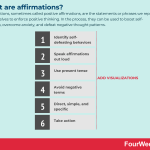
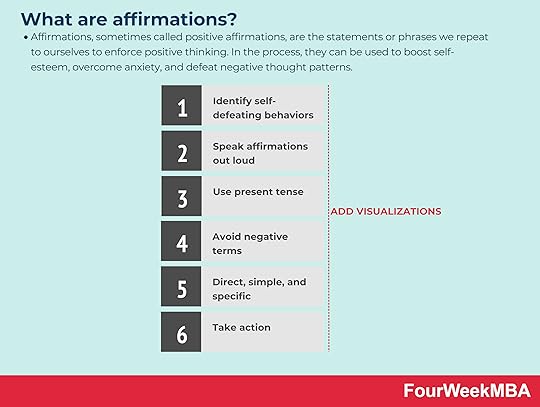
Affirmations, sometimes called positive affirmations, are the statements or phrases we repeat to ourselves to enforce positive thinking. In the process, they can be used to boost self-esteem, overcome anxiety, and defeat negative thought patterns.
Understanding affirmationsAffirmations are short statements whose primary role is to enforce positive thinking.
Some believe positive affirmations are a magic bullet while others dismiss them as baseless pseudoscience.
The real truth, however, lies somewhere in between.
Researchers have not conclusively proven that affirmations enable us to manifest what we desire, but they are based on many psychological processes backed by scientific studies.
Affirmations and neuroplasticityNeuroplasticity research looks at how the brain alters its structure, functions, or connections in response to internal and external stimuli.
Studies show that affirmations can strengthen positive neural pathways in the brain and decrease our reliance on negative pathways that no longer serve us.
Neuroplasticity can also be used to explain how when we believe a desired future state will occur, it is more likely to eventuate.
This is caused by the brain’s occasional tendency to be unable to tell the difference between imagination and reality, and the good news is we can use this to our advantage.
Imagine you need to prepare for an important job interview. First picture yourself confidently striding into the interview room, answering the questions with purpose, and impressing the panel.
When you do this, you activate many of the same areas of the brain that would be activated had you experienced the situation in real life.
When affirmations are repeated often enough, the brain starts to take them as fact. Over time, self-belief increases and your actions usually follow.
How to use affirmationsHere is how you can use affirmations to your advantage and maximize their effectiveness:
Identify self-defeating behaviors – take some time to determine which emotions, thoughts, or behaviors are not in your best interests. Speak affirmations out loud – compared to reading, speaking your affirmations out loud increases the likelihood of new connections or desirable activity in the brain. Incense or candles can also be used when repeating affirmations such that any time they are lit, beneficial areas of the brain are reactivated.Use present tense – avoid terms like “soon”, “later”, or “better” when creating your affirmations. In other words, replace “I will be fit and eat healthier soon” with “I am a fit and healthy eater” and remember that affirmations are more like assurances and less like objectives that need to be ticked off.Avoid negative terms – do not create affirmations with negative terms (even if the intent is positive). For example, the affirmation “I am not a nervous and hesitant interview candidate” may be detrimental because it focuses on what you are trying to avoid. Always base your affirmations on positive outcomes.Direct, simple, and specific – to ensure your conscious mind has agreement from your unconscious mind, make the affirmation as direct, simple, and specific as possible. For example: “I earn a full time income working 25 hours a week from home. I make positive contributions to my company and I enjoy extra time to spend with my husband and kids.”Take action – simply stating an affirmation can boost your confidence and motivation, but actions speak louder than words. If you want to run a business based on one of your passions, register the business or buy the domain name.Add visualizations – another way to increase the effectiveness of affirmations is to visualize what you want in your subconscious. If it’s a new vacation home, picture a secluded cabin in the woods. What you can smell, hear, see, and taste? Make it as real as possible.Affirmation examplesBelow we have listed some affirmation examples in various contexts.
Business affirmationsI believe in myself and in my ability to succeed in all that I do.As I become more successful, I am able to help more people.I am a wonderful business coach and my schedule is always booked with clients who want to work with me.Money is no longer a problem for me because I have more than I will ever need or desire. I donate a sizeable portion of my income to charity and I am still free to do as I please when it pleases me.It is my chance to shine and I will accept the financial rewards my business affords me.My ideas sell because I believe in them.I let go of self-doubt and pessimism whenever I encounter an obstacle or unfair colleague at work.Health affirmationsMy food choices are healthy and balanced.I am a person that invests time in my physical and mental health.I enjoy moving my body on a daily basis and I listen to what my body tells me.I am always open to new opportunities or ideas to improve my health.My breathing is slow and steady and I release negative thoughts.Family affirmationsI commit to spending time with my family even when there are pressing issues at work.When I spend time with my family, we make happy memories that will last a lifetime and become closer.Every member of my family has unique strengths and weaknesses and contributes to the family unit in their own way.I am a person who does not break promises made to family members.My family is accepting of the fact that I am not perfect and offer unconditional love anyway.Key takeaways:Affirmations are short statements used to enforce positive thinking. Some believe positive affirmations are a magic bullet while others dismiss them as baseless pseudoscience. Affirmations strengthen positive neural pathways in the brain and decrease our reliance on negative pathways that no longer serve us. They can also be used to imagine desirable future states and activate the same areas of the brain that are activated had the state been experienced in reality.To maximize the effectiveness of affirmations, the individual must start by identifying thoughts, behaviors, or emotions that are holding them back. Once formulated, it is important to speak the affirmations out loud, use the present tense, avoid negative terms, and add visualizations.Main Free Guides:
Business ModelsBusiness StrategyBusiness DevelopmentDigital Business ModelsDistribution ChannelsMarketing StrategyPlatform Business ModelsTech Business ModelThe post What are affirmations? appeared first on FourWeekMBA.
How does Evernote make money? The Evernote business model in a nutshell
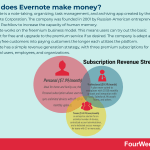
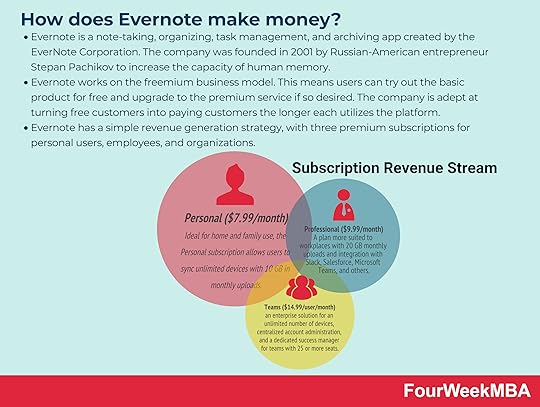 Evernote is a note-taking, organizing, task management, and archiving app created by the EverNote Corporation. The company was founded in 2001 by Russian-American entrepreneur Stepan Pachikov to increase the capacity of human memory.Evernote works on the freemium business model. This means users can try out the basic product for free and upgrade to the premium service if so desired. The company is adept at turning free customers into paying customers the longer each utilizes the platform.Evernote has a simple revenue generation strategy, with three premium subscriptions for personal users, employees, and organizations.Origin story
Evernote is a note-taking, organizing, task management, and archiving app created by the EverNote Corporation. The company was founded in 2001 by Russian-American entrepreneur Stepan Pachikov to increase the capacity of human memory.Evernote works on the freemium business model. This means users can try out the basic product for free and upgrade to the premium service if so desired. The company is adept at turning free customers into paying customers the longer each utilizes the platform.Evernote has a simple revenue generation strategy, with three premium subscriptions for personal users, employees, and organizations.Origin storyEvernote is a note-taking, organizing, task management, and archiving app created by the EverNote Corporation. The company was founded in 2001 by Russian-American entrepreneur Stepan Pachikov.
Pachikov created Evernote to extend the human memory and make things easier to find, suggesting that the human memory was fragile and unreliable:
“We all have hundreds of thousands of pieces of information, but it’s useless if we can’t find any of it. In business, the worst thing we can say is, ‘Oh, I’m sorry, I forgot your name.’”
The original EverNote incorporated the handwriting recognition technology that Apple underutilized in Newton, an early personal digital assistant first released in 1993.
Launched for Windows in 2004, users could write notes the old-fashioned way and search for specific notes according to date, keyword, topic, location, or contacts.
Pachikov met Phil Libin in 2007, a man with strong business acumen whom he believed could take the company forward.
Libin was subsequently appointed CEO and grew Evernote by steering the app away from desktops and toward the new frontier in smartphones.
Four years later, Evernote boasted 11 million users as engineers worked tirelessly to ensure the app was ready as each new app marketplace was launched.
The company raised four successful rounds of funding between 2010 and 2014 with Evernote enjoying gradual, steady, and entirely organic growth. Flush with cash, the company then embarked on a series of disastrous product launches.
One such product, Evernote Food, failed predominantly because it pre-dated the food-selfie era and was too similar to the core platform. Despite these setbacks, Evernote achieved unicorn status during this period in May 2012.
Today, Evernote remains the most popular app for life organization, note-taking, and project planning with over 225 million active global users. The platform has inspired the creation of many similar services, including Microsoft OneNote, Google Keep, Hive Notes, and Dropbox Paper.
Evernote revenue generationEvernote works on the freemium business model. This means users can try out the basic product for free and upgrade to the premium service if they choose to do so.
The company has a proven track record of converting casual users into paying customers. While just 0.5% of new users purchase a premium service, this number increases to 7% after one year of use, 11% after two years, and 25% after four to five years.
With that said, let’s take a look at the premium offerings in more detail.
Premium subscriptionsFor individuals and teams, there are three premium subscriptions to choose from:
Personal ($7.99/month) – ideal for home and family use, the Personal subscription allows users to sync unlimited devices with 10 GB in monthly uploads.Professional ($9.99/month) – a plan more suited to workplaces with 20 GB monthly uploads and integration with Slack, Salesforce, Microsoft Teams, and others.Teams ($14.99/user/month) – an enterprise solution for an unlimited number of devices, centralized account administration, and a dedicated success manager for teams with 25 or more seats.Main Free Guides:
Business ModelsBusiness CompetitionBusiness StrategyBusiness DevelopmentDigital Business ModelsDistribution ChannelsMarketing StrategyPlatform Business ModelsRevenue ModelsTech Business ModelsBlockchain Business Models FrameworkRelated: What Is A B2B2C Business Model?
Related Business Model Types A platform business model generates value by enabling interactions between people, groups, and users by leveraging network effects. Platform business models usually comprise two sides: supply and demand. Kicking off the interactions between those two sides is one of the crucial elements for a platform business model success.
A platform business model generates value by enabling interactions between people, groups, and users by leveraging network effects. Platform business models usually comprise two sides: supply and demand. Kicking off the interactions between those two sides is one of the crucial elements for a platform business model success. A marketplace is a platform where buyers and sellers interact and transact. The platform acts as a marketplace that will generate revenues in fees from one or all the parties involved in the transaction. Usually, marketplaces can be classified in several ways, like those selling services vs. products or those connecting buyers and sellers at B2B, B2C, or C2C level. And those marketplaces connecting two core players, or more.
A marketplace is a platform where buyers and sellers interact and transact. The platform acts as a marketplace that will generate revenues in fees from one or all the parties involved in the transaction. Usually, marketplaces can be classified in several ways, like those selling services vs. products or those connecting buyers and sellers at B2B, B2C, or C2C level. And those marketplaces connecting two core players, or more. A network effect is a phenomenon in which as more people or users join a platform, the more the value of the service offered by the platform improves for those joining afterward.
A network effect is a phenomenon in which as more people or users join a platform, the more the value of the service offered by the platform improves for those joining afterward. In an asymmetric business model, the organization doesn’t monetize the user directly, but it leverages the data users provide coupled with technology, thus have a key customer pay to sustain the core asset. For example, Google makes money by leveraging users’ data, combined with its algorithms sold to advertisers for visibility.
In an asymmetric business model, the organization doesn’t monetize the user directly, but it leverages the data users provide coupled with technology, thus have a key customer pay to sustain the core asset. For example, Google makes money by leveraging users’ data, combined with its algorithms sold to advertisers for visibility.Attention Merchant Business Model
 In an asymmetric business model, the organization doesn’t monetize the user directly, but it leverages the data users provide coupled with technology, thus having a key customer pay to sustain the core asset. For example, Google makes money by leveraging users’ data, combined with its algorithms sold to advertisers for visibility. This is how attention merchants make monetize their business models.
In an asymmetric business model, the organization doesn’t monetize the user directly, but it leverages the data users provide coupled with technology, thus having a key customer pay to sustain the core asset. For example, Google makes money by leveraging users’ data, combined with its algorithms sold to advertisers for visibility. This is how attention merchants make monetize their business models.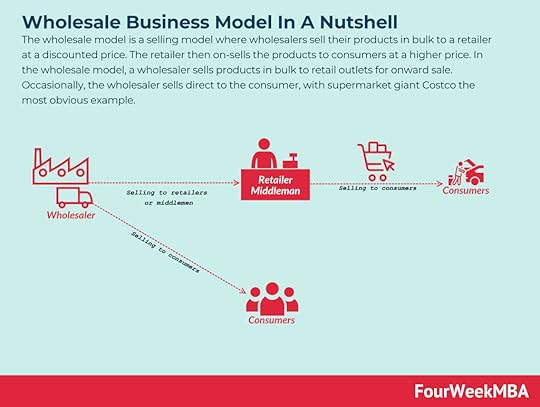 The wholesale model is a selling model where wholesalers sell their products in bulk to a retailer at a discounted price. The retailer then on-sells the products to consumers at a higher price. In the wholesale model, a wholesaler sells products in bulk to retail outlets for onward sale. Occasionally, the wholesaler sells direct to the consumer, with supermarket giant Costco the most obvious example.
The wholesale model is a selling model where wholesalers sell their products in bulk to a retailer at a discounted price. The retailer then on-sells the products to consumers at a higher price. In the wholesale model, a wholesaler sells products in bulk to retail outlets for onward sale. Occasionally, the wholesaler sells direct to the consumer, with supermarket giant Costco the most obvious example.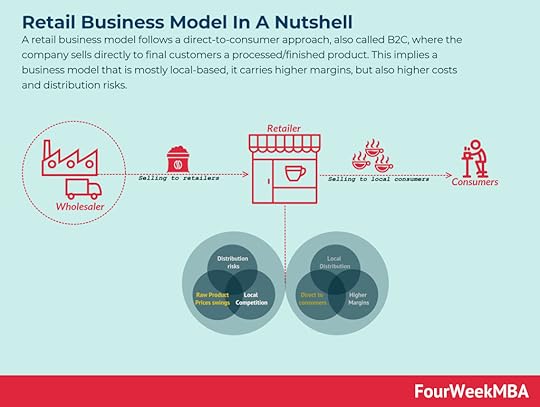 A retail business model follows a direct-to-consumer approach, also called B2C, where the company sells directly to final customers a processed/finished product. This implies a business model that is mostly local-based, it carries higher margins, but also higher costs and distribution risks.
A retail business model follows a direct-to-consumer approach, also called B2C, where the company sells directly to final customers a processed/finished product. This implies a business model that is mostly local-based, it carries higher margins, but also higher costs and distribution risks.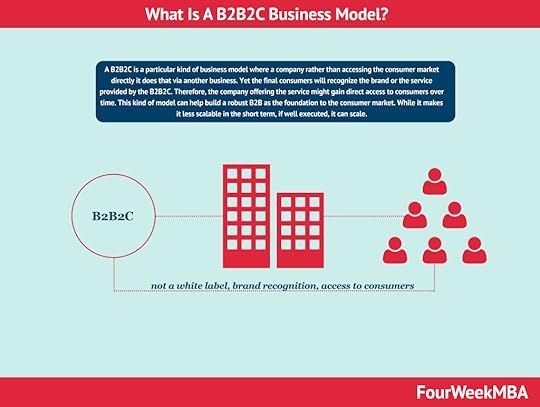 A B2B2C is a particular kind of business model where a company, rather than accessing the consumer market directly, it does that via another business. Yet the final consumers will recognize the brand or the service provided by the B2B2C. The company offering the service might gain direct access to consumers over time.
A B2B2C is a particular kind of business model where a company, rather than accessing the consumer market directly, it does that via another business. Yet the final consumers will recognize the brand or the service provided by the B2B2C. The company offering the service might gain direct access to consumers over time.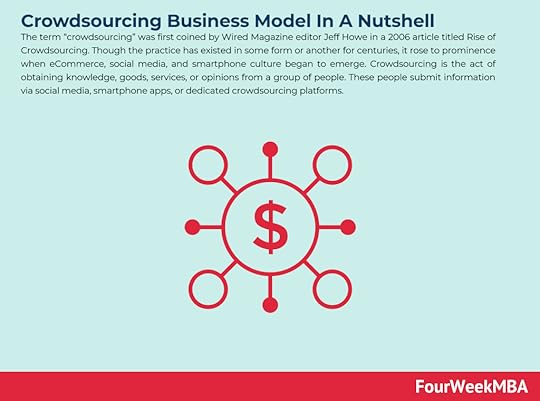 The term “crowdsourcing” was first coined by Wired Magazine editor Jeff Howe in a 2006 article titled Rise of Crowdsourcing. Though the practice has existed in some form or another for centuries, it rose to prominence when eCommerce, social media, and smartphone culture began to emerge. Crowdsourcing is the act of obtaining knowledge, goods, services, or opinions from a group of people. These people submit information via social media, smartphone apps, or dedicated crowdsourcing platforms.
The term “crowdsourcing” was first coined by Wired Magazine editor Jeff Howe in a 2006 article titled Rise of Crowdsourcing. Though the practice has existed in some form or another for centuries, it rose to prominence when eCommerce, social media, and smartphone culture began to emerge. Crowdsourcing is the act of obtaining knowledge, goods, services, or opinions from a group of people. These people submit information via social media, smartphone apps, or dedicated crowdsourcing platforms.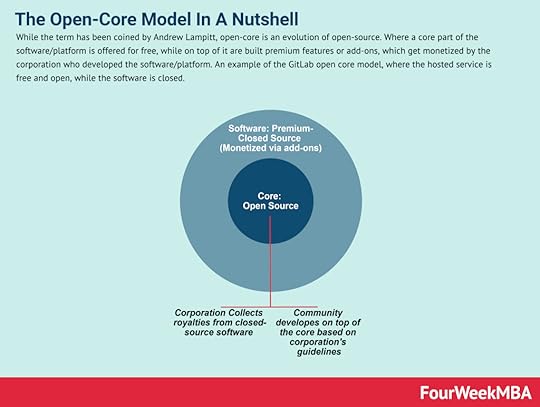 While the term has been coined by Andrew Lampitt, open-core is an evolution of open-source. Where a core part of the software/platform is offered for free, while on top of it are built premium features or add-ons, which get monetized by the corporation who developed the software/platform. An example of the GitLab open core model, where the hosted service is free and open, while the software is closed.
While the term has been coined by Andrew Lampitt, open-core is an evolution of open-source. Where a core part of the software/platform is offered for free, while on top of it are built premium features or add-ons, which get monetized by the corporation who developed the software/platform. An example of the GitLab open core model, where the hosted service is free and open, while the software is closed.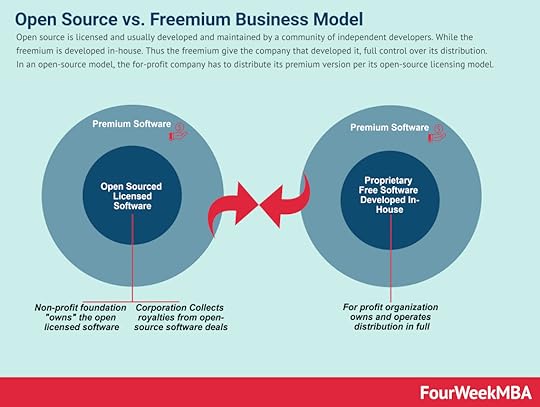 Open source is licensed and usually developed and maintained by a community of independent developers. While the freemium is developed in-house. Thus the freemium give the company that developed it, full control over its distribution. In an open-source model, the for-profit company has to distribute its premium version per its open-source licensing model.
Open source is licensed and usually developed and maintained by a community of independent developers. While the freemium is developed in-house. Thus the freemium give the company that developed it, full control over its distribution. In an open-source model, the for-profit company has to distribute its premium version per its open-source licensing model.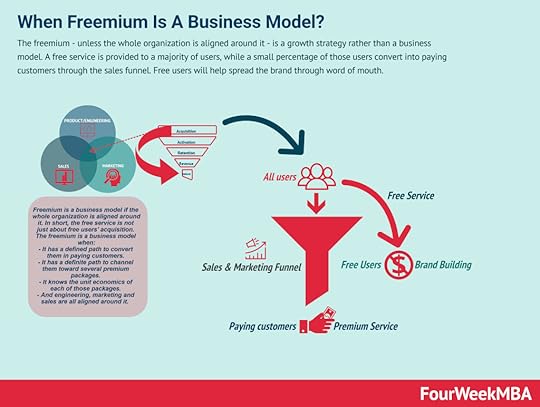 The freemium – unless the whole organization is aligned around it – is a growth strategy rather than a business model. A free service is provided to a majority of users, while a small percentage of those users convert into paying customers through the sales funnel. Free users will help spread the brand through word of mouth.
The freemium – unless the whole organization is aligned around it – is a growth strategy rather than a business model. A free service is provided to a majority of users, while a small percentage of those users convert into paying customers through the sales funnel. Free users will help spread the brand through word of mouth.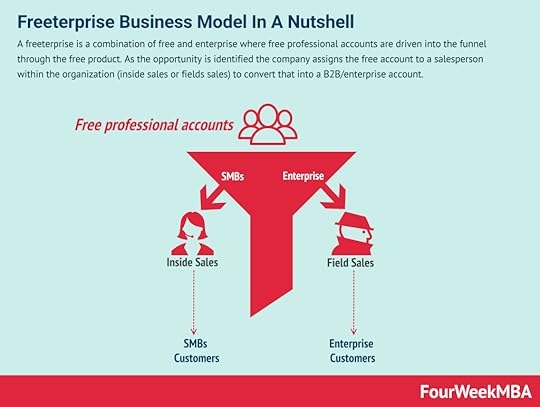 A freeterprise is a combination of free and enterprise where free professional accounts are driven into the funnel through the free product. As the opportunity is identified the company assigns the free account to a salesperson within the organization (inside sales or fields sales) to convert that into a B2B/enterprise account.
A freeterprise is a combination of free and enterprise where free professional accounts are driven into the funnel through the free product. As the opportunity is identified the company assigns the free account to a salesperson within the organization (inside sales or fields sales) to convert that into a B2B/enterprise account.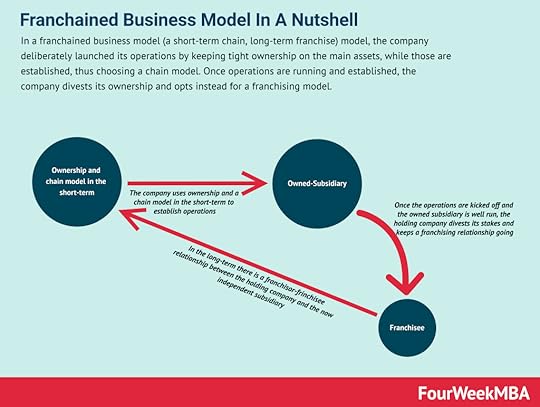 In a franchained business model (a short-term chain, long-term franchise) model, the company deliberately launched its operations by keeping tight ownership on the main assets, while those are established, thus choosing a chain model. Once operations are running and established, the company divests its ownership and opts instead for a franchising model.
In a franchained business model (a short-term chain, long-term franchise) model, the company deliberately launched its operations by keeping tight ownership on the main assets, while those are established, thus choosing a chain model. Once operations are running and established, the company divests its ownership and opts instead for a franchising model.The post How does Evernote make money? The Evernote business model in a nutshell appeared first on FourWeekMBA.
How does DietBet make money?
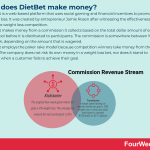
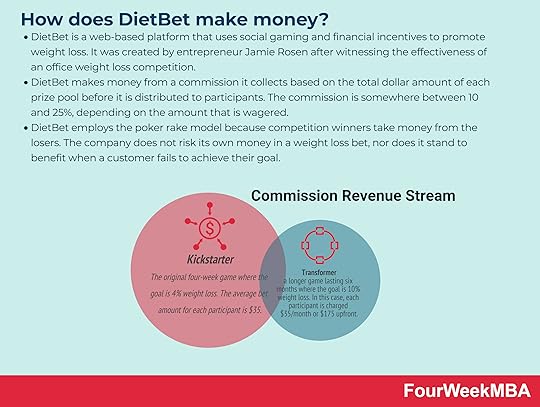 DietBet is a web-based platform that uses social gaming and financial incentives to promote weight loss. It was created by entrepreneur Jamie Rosen after witnessing the effectiveness of an office weight loss competition.DietBet makes money from a commission it collects based on the total dollar amount of each prize pool before it is distributed to participants. The commission is somewhere between 10 and 25%, depending on the amount that is wagered.DietBet employs the poker rake model because competition winners take money from the losers. The company does not risk its own money in a weight loss bet, nor does it stand to benefit when a customer fails to achieve their goal.Origin story
DietBet is a web-based platform that uses social gaming and financial incentives to promote weight loss. It was created by entrepreneur Jamie Rosen after witnessing the effectiveness of an office weight loss competition.DietBet makes money from a commission it collects based on the total dollar amount of each prize pool before it is distributed to participants. The commission is somewhere between 10 and 25%, depending on the amount that is wagered.DietBet employs the poker rake model because competition winners take money from the losers. The company does not risk its own money in a weight loss bet, nor does it stand to benefit when a customer fails to achieve their goal.Origin storyDietBet is a web-based platform that uses social gaming and financial incentives to promote weight loss.
The platform was created by entrepreneur Jamie Rosen in 2011 who was inspired by friends who were competing in an office weight loss competition.
Rosen noticed that his friends seemed more motivated to lose weight because of an evolutionary tendency to mimic the people around them.
This tendency, he posited, was a better form of weight loss than traditional methods advocating proper nutrition and exercise.
DietBet was eventually launched in 2013 on a simple premise. Users join a social dieting campaign where each member is challenged to lose 4% of their body weight in four weeks. Each must also bet on themselves by paying into a pot.
Those who manage to achieve their stated weight loss goal share the total pot proceeds between them. In this way, the platform makes weight loss fun, exciting, and competitive.
The DietBet weight loss game has now been played by over 300,000 players in more than 100 countries around the world.
The biggest pot on the platform netted the participants a combined $366,060, though Rosen suggests social interaction and the adoption of sustainable healthy eating habits is a more important measure of success.
These characteristics have enabled DietBet users to collectively lose some 3.6 million pounds of body weight.
DietBet revenue generationDietBet makes money from a commission it collects from the total dollar amount of each pot. This commission is used to pay for transaction, employee, and other company expenses.
Some of the pot commission also pays for DietBet Referees, many of whom former players providing important weight-loss support and training to the DietBet community.
The exact amount collected is in the range of 10-25%, depending on the amount wagered or the game selected.
For those seeking to shed a few pounds, there are two game options:
Kickstarter – the original four-week game where the goal is 4% weight loss. The average bet amount for each participant is $35.Transformer – a longer game lasting six months where the goal is 10% weight loss. In this case, each participant is charged $35/month or $175 upfront.Note that the commission is taken from the gross pot before it is paid out to winners. In this way, the players who fail to meet their weight loss goals do not incur any fees.
The strategy DietBet employs is sometimes referred to as the poker rake model, where competition winners take money from the losers. Importantly, the company does not risk any of its own money and has no financial incentive for its customers to lose.
Main Free Guides:
Business ModelsBusiness CompetitionBusiness StrategyBusiness DevelopmentDigital Business ModelsDistribution ChannelsMarketing StrategyPlatform Business ModelsRevenue ModelsTech Business ModelsBlockchain Business Models FrameworkRelated: What Is A B2B2C Business Model?
Related Business Model Types A platform business model generates value by enabling interactions between people, groups, and users by leveraging network effects. Platform business models usually comprise two sides: supply and demand. Kicking off the interactions between those two sides is one of the crucial elements for a platform business model success.
A platform business model generates value by enabling interactions between people, groups, and users by leveraging network effects. Platform business models usually comprise two sides: supply and demand. Kicking off the interactions between those two sides is one of the crucial elements for a platform business model success. A marketplace is a platform where buyers and sellers interact and transact. The platform acts as a marketplace that will generate revenues in fees from one or all the parties involved in the transaction. Usually, marketplaces can be classified in several ways, like those selling services vs. products or those connecting buyers and sellers at B2B, B2C, or C2C level. And those marketplaces connecting two core players, or more.
A marketplace is a platform where buyers and sellers interact and transact. The platform acts as a marketplace that will generate revenues in fees from one or all the parties involved in the transaction. Usually, marketplaces can be classified in several ways, like those selling services vs. products or those connecting buyers and sellers at B2B, B2C, or C2C level. And those marketplaces connecting two core players, or more. A network effect is a phenomenon in which as more people or users join a platform, the more the value of the service offered by the platform improves for those joining afterward.
A network effect is a phenomenon in which as more people or users join a platform, the more the value of the service offered by the platform improves for those joining afterward. In an asymmetric business model, the organization doesn’t monetize the user directly, but it leverages the data users provide coupled with technology, thus have a key customer pay to sustain the core asset. For example, Google makes money by leveraging users’ data, combined with its algorithms sold to advertisers for visibility.
In an asymmetric business model, the organization doesn’t monetize the user directly, but it leverages the data users provide coupled with technology, thus have a key customer pay to sustain the core asset. For example, Google makes money by leveraging users’ data, combined with its algorithms sold to advertisers for visibility.Attention Merchant Business Model
 In an asymmetric business model, the organization doesn’t monetize the user directly, but it leverages the data users provide coupled with technology, thus having a key customer pay to sustain the core asset. For example, Google makes money by leveraging users’ data, combined with its algorithms sold to advertisers for visibility. This is how attention merchants make monetize their business models.
In an asymmetric business model, the organization doesn’t monetize the user directly, but it leverages the data users provide coupled with technology, thus having a key customer pay to sustain the core asset. For example, Google makes money by leveraging users’ data, combined with its algorithms sold to advertisers for visibility. This is how attention merchants make monetize their business models. The wholesale model is a selling model where wholesalers sell their products in bulk to a retailer at a discounted price. The retailer then on-sells the products to consumers at a higher price. In the wholesale model, a wholesaler sells products in bulk to retail outlets for onward sale. Occasionally, the wholesaler sells direct to the consumer, with supermarket giant Costco the most obvious example.
The wholesale model is a selling model where wholesalers sell their products in bulk to a retailer at a discounted price. The retailer then on-sells the products to consumers at a higher price. In the wholesale model, a wholesaler sells products in bulk to retail outlets for onward sale. Occasionally, the wholesaler sells direct to the consumer, with supermarket giant Costco the most obvious example. A retail business model follows a direct-to-consumer approach, also called B2C, where the company sells directly to final customers a processed/finished product. This implies a business model that is mostly local-based, it carries higher margins, but also higher costs and distribution risks.
A retail business model follows a direct-to-consumer approach, also called B2C, where the company sells directly to final customers a processed/finished product. This implies a business model that is mostly local-based, it carries higher margins, but also higher costs and distribution risks. A B2B2C is a particular kind of business model where a company, rather than accessing the consumer market directly, it does that via another business. Yet the final consumers will recognize the brand or the service provided by the B2B2C. The company offering the service might gain direct access to consumers over time.
A B2B2C is a particular kind of business model where a company, rather than accessing the consumer market directly, it does that via another business. Yet the final consumers will recognize the brand or the service provided by the B2B2C. The company offering the service might gain direct access to consumers over time. The term “crowdsourcing” was first coined by Wired Magazine editor Jeff Howe in a 2006 article titled Rise of Crowdsourcing. Though the practice has existed in some form or another for centuries, it rose to prominence when eCommerce, social media, and smartphone culture began to emerge. Crowdsourcing is the act of obtaining knowledge, goods, services, or opinions from a group of people. These people submit information via social media, smartphone apps, or dedicated crowdsourcing platforms.
The term “crowdsourcing” was first coined by Wired Magazine editor Jeff Howe in a 2006 article titled Rise of Crowdsourcing. Though the practice has existed in some form or another for centuries, it rose to prominence when eCommerce, social media, and smartphone culture began to emerge. Crowdsourcing is the act of obtaining knowledge, goods, services, or opinions from a group of people. These people submit information via social media, smartphone apps, or dedicated crowdsourcing platforms. While the term has been coined by Andrew Lampitt, open-core is an evolution of open-source. Where a core part of the software/platform is offered for free, while on top of it are built premium features or add-ons, which get monetized by the corporation who developed the software/platform. An example of the GitLab open core model, where the hosted service is free and open, while the software is closed.
While the term has been coined by Andrew Lampitt, open-core is an evolution of open-source. Where a core part of the software/platform is offered for free, while on top of it are built premium features or add-ons, which get monetized by the corporation who developed the software/platform. An example of the GitLab open core model, where the hosted service is free and open, while the software is closed. Open source is licensed and usually developed and maintained by a community of independent developers. While the freemium is developed in-house. Thus the freemium give the company that developed it, full control over its distribution. In an open-source model, the for-profit company has to distribute its premium version per its open-source licensing model.
Open source is licensed and usually developed and maintained by a community of independent developers. While the freemium is developed in-house. Thus the freemium give the company that developed it, full control over its distribution. In an open-source model, the for-profit company has to distribute its premium version per its open-source licensing model. The freemium – unless the whole organization is aligned around it – is a growth strategy rather than a business model. A free service is provided to a majority of users, while a small percentage of those users convert into paying customers through the sales funnel. Free users will help spread the brand through word of mouth.
The freemium – unless the whole organization is aligned around it – is a growth strategy rather than a business model. A free service is provided to a majority of users, while a small percentage of those users convert into paying customers through the sales funnel. Free users will help spread the brand through word of mouth. A freeterprise is a combination of free and enterprise where free professional accounts are driven into the funnel through the free product. As the opportunity is identified the company assigns the free account to a salesperson within the organization (inside sales or fields sales) to convert that into a B2B/enterprise account.
A freeterprise is a combination of free and enterprise where free professional accounts are driven into the funnel through the free product. As the opportunity is identified the company assigns the free account to a salesperson within the organization (inside sales or fields sales) to convert that into a B2B/enterprise account. In a franchained business model (a short-term chain, long-term franchise) model, the company deliberately launched its operations by keeping tight ownership on the main assets, while those are established, thus choosing a chain model. Once operations are running and established, the company divests its ownership and opts instead for a franchising model.
In a franchained business model (a short-term chain, long-term franchise) model, the company deliberately launched its operations by keeping tight ownership on the main assets, while those are established, thus choosing a chain model. Once operations are running and established, the company divests its ownership and opts instead for a franchising model.The post How does DietBet make money? appeared first on FourWeekMBA.
How Does Blinkist Make Money? The Blinkist Business Model In A Nutshell
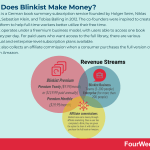
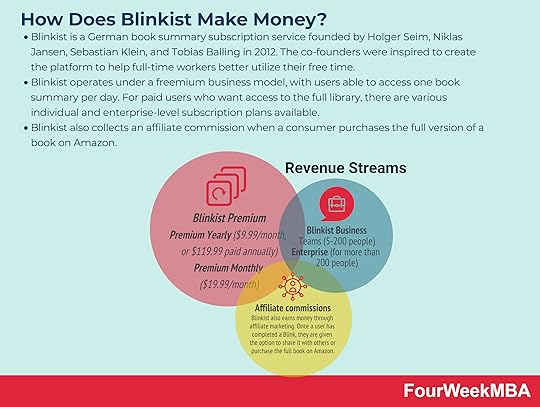 Blinkist is a German book summary subscription service founded by Holger Seim, Niklas Jansen, Sebastian Klein, and Tobias Balling in 2012. The co-founders were inspired to create the platform to help full-time workers better utilize their free time.Blinkist operates under a freemium business model, with users able to access one book summary per day. For paid users who want access to the full library, there are various individual and enterprise-level subscription plans available.Blinkist also collects an affiliate commission when a consumer purchases the full version of a book on Amazon.Origin story
Blinkist is a German book summary subscription service founded by Holger Seim, Niklas Jansen, Sebastian Klein, and Tobias Balling in 2012. The co-founders were inspired to create the platform to help full-time workers better utilize their free time.Blinkist operates under a freemium business model, with users able to access one book summary per day. For paid users who want access to the full library, there are various individual and enterprise-level subscription plans available.Blinkist also collects an affiliate commission when a consumer purchases the full version of a book on Amazon.Origin storyBlinkist is a German subscription service founded by Holger Seim, Niklas Jansen, Sebastian Klein, and Tobias Balling in 2012.
The platform summarises over 3,000 best-selling non-fiction books, with each summary taking approximately fifteen minutes to read,
The idea for Blinkist came after the co-founders joined the workforce and wanted a way to read and learn despite enjoying less free time.
They realized that most people experienced the same problem and those who did find the time to read were constantly distracted by their devices.
Seeking to help readers make better use of their time, the co-founders started compiling the key insights from a variety of popular non-fiction books.
To increase the likelihood that even the busiest reader would remain engaged, it was important that each insight could be read within fifteen minutes. Each fifteen-minute summary they called a Blink.
In the beginning, Blinkist garnered little investor interest and was repeatedly refused funding. But Seim, Jansen, Klein, and Balling then quit their full-time jobs to work on the app full time in any case.
Once Blinkist was launched, it took three months to reach just 100 downloads. The user base experienced more rapid growth after American VC firm Insight Partners took notice of Blinkist and contributed $35 million.
Growth was further enabled by the recruitment of a robust tech team, with the company securing former SoundCloud, Twitter, and Google staff.
Blinkist also hired an army of writers and experts to read the books and create Blinks that were memorable, concise, and easy to understand.
Today, Blinkist has over 20 million users with access to over 5,000 non-fiction books from the realms of philosophy, history, politics, productivity, mindfulness, personal development, corporate culture, entrepreneurship, and creativity.
Blinkist revenue generationBlinkist operates on the freemium business model with both a free and paid offering.
Free users receive access to one book per day that the Blinkist team selects. For unlimited access to every book hosted on the platform, there are various subscriptions available for individuals and businesses.
Blinkist PremiumBlinkist Premium gives users unlimited access to all audio and text Blinks on the website and in the app. They also receive a discount on audiobook purchases.
There are two options here:
Premium Yearly ($9.99/month, or $119.99 paid annually) – note that there is a free 7-day trial here with access to the full Blinkist library. Premium Monthly ($19.99/month) – with the monthly plan, there is no free trial and the subscription is twice the price of the yearly commitment.Blinkist BusinessBlinkist Business is a product helping businesses cultivate curiosity and innovation within their teams. There are also two subscription options available for businesses, including:
Teams (5-200 people) – featuring access to Blinkist Premium, engagement resources, and an account management portal. Prices depend on the number of required users, or seats. For example, the price of 10 seats is $590 and the price of 200 seats is $7500. A middle range of option of 100 seats is $4600.Enterprise (for more than 200 people) – featuring all Teams features plus dedicated customer support, curated learning paths, customizable home screen, and learning management system (LMS) integration. Enterprise customers must book a demo to receive a quote.Affiliate commissionsBlinkist also earns money through affiliate marketing. Once a user has completed a Blink, they are given the option to share it with others or purchase the full book on Amazon.
The company is then compensated with a commission from Amazon if a consumer makes a purchase there.
Main Free Guides:
Business ModelsBusiness CompetitionBusiness StrategyBusiness DevelopmentDigital Business ModelsDistribution ChannelsMarketing StrategyPlatform Business ModelsRevenue ModelsTech Business ModelsBlockchain Business Models FrameworkRelated: What Is A B2B2C Business Model?
Related Business Model Types A platform business model generates value by enabling interactions between people, groups, and users by leveraging network effects. Platform business models usually comprise two sides: supply and demand. Kicking off the interactions between those two sides is one of the crucial elements for a platform business model success.
A platform business model generates value by enabling interactions between people, groups, and users by leveraging network effects. Platform business models usually comprise two sides: supply and demand. Kicking off the interactions between those two sides is one of the crucial elements for a platform business model success. A marketplace is a platform where buyers and sellers interact and transact. The platform acts as a marketplace that will generate revenues in fees from one or all the parties involved in the transaction. Usually, marketplaces can be classified in several ways, like those selling services vs. products or those connecting buyers and sellers at B2B, B2C, or C2C level. And those marketplaces connecting two core players, or more.
A marketplace is a platform where buyers and sellers interact and transact. The platform acts as a marketplace that will generate revenues in fees from one or all the parties involved in the transaction. Usually, marketplaces can be classified in several ways, like those selling services vs. products or those connecting buyers and sellers at B2B, B2C, or C2C level. And those marketplaces connecting two core players, or more. A network effect is a phenomenon in which as more people or users join a platform, the more the value of the service offered by the platform improves for those joining afterward.
A network effect is a phenomenon in which as more people or users join a platform, the more the value of the service offered by the platform improves for those joining afterward. In an asymmetric business model, the organization doesn’t monetize the user directly, but it leverages the data users provide coupled with technology, thus have a key customer pay to sustain the core asset. For example, Google makes money by leveraging users’ data, combined with its algorithms sold to advertisers for visibility.
In an asymmetric business model, the organization doesn’t monetize the user directly, but it leverages the data users provide coupled with technology, thus have a key customer pay to sustain the core asset. For example, Google makes money by leveraging users’ data, combined with its algorithms sold to advertisers for visibility.Attention Merchant Business Model
 In an asymmetric business model, the organization doesn’t monetize the user directly, but it leverages the data users provide coupled with technology, thus having a key customer pay to sustain the core asset. For example, Google makes money by leveraging users’ data, combined with its algorithms sold to advertisers for visibility. This is how attention merchants make monetize their business models.
In an asymmetric business model, the organization doesn’t monetize the user directly, but it leverages the data users provide coupled with technology, thus having a key customer pay to sustain the core asset. For example, Google makes money by leveraging users’ data, combined with its algorithms sold to advertisers for visibility. This is how attention merchants make monetize their business models. The wholesale model is a selling model where wholesalers sell their products in bulk to a retailer at a discounted price. The retailer then on-sells the products to consumers at a higher price. In the wholesale model, a wholesaler sells products in bulk to retail outlets for onward sale. Occasionally, the wholesaler sells direct to the consumer, with supermarket giant Costco the most obvious example.
The wholesale model is a selling model where wholesalers sell their products in bulk to a retailer at a discounted price. The retailer then on-sells the products to consumers at a higher price. In the wholesale model, a wholesaler sells products in bulk to retail outlets for onward sale. Occasionally, the wholesaler sells direct to the consumer, with supermarket giant Costco the most obvious example. A retail business model follows a direct-to-consumer approach, also called B2C, where the company sells directly to final customers a processed/finished product. This implies a business model that is mostly local-based, it carries higher margins, but also higher costs and distribution risks.
A retail business model follows a direct-to-consumer approach, also called B2C, where the company sells directly to final customers a processed/finished product. This implies a business model that is mostly local-based, it carries higher margins, but also higher costs and distribution risks. A B2B2C is a particular kind of business model where a company, rather than accessing the consumer market directly, it does that via another business. Yet the final consumers will recognize the brand or the service provided by the B2B2C. The company offering the service might gain direct access to consumers over time.
A B2B2C is a particular kind of business model where a company, rather than accessing the consumer market directly, it does that via another business. Yet the final consumers will recognize the brand or the service provided by the B2B2C. The company offering the service might gain direct access to consumers over time. The term “crowdsourcing” was first coined by Wired Magazine editor Jeff Howe in a 2006 article titled Rise of Crowdsourcing. Though the practice has existed in some form or another for centuries, it rose to prominence when eCommerce, social media, and smartphone culture began to emerge. Crowdsourcing is the act of obtaining knowledge, goods, services, or opinions from a group of people. These people submit information via social media, smartphone apps, or dedicated crowdsourcing platforms.
The term “crowdsourcing” was first coined by Wired Magazine editor Jeff Howe in a 2006 article titled Rise of Crowdsourcing. Though the practice has existed in some form or another for centuries, it rose to prominence when eCommerce, social media, and smartphone culture began to emerge. Crowdsourcing is the act of obtaining knowledge, goods, services, or opinions from a group of people. These people submit information via social media, smartphone apps, or dedicated crowdsourcing platforms. While the term has been coined by Andrew Lampitt, open-core is an evolution of open-source. Where a core part of the software/platform is offered for free, while on top of it are built premium features or add-ons, which get monetized by the corporation who developed the software/platform. An example of the GitLab open core model, where the hosted service is free and open, while the software is closed.
While the term has been coined by Andrew Lampitt, open-core is an evolution of open-source. Where a core part of the software/platform is offered for free, while on top of it are built premium features or add-ons, which get monetized by the corporation who developed the software/platform. An example of the GitLab open core model, where the hosted service is free and open, while the software is closed. Open source is licensed and usually developed and maintained by a community of independent developers. While the freemium is developed in-house. Thus the freemium give the company that developed it, full control over its distribution. In an open-source model, the for-profit company has to distribute its premium version per its open-source licensing model.
Open source is licensed and usually developed and maintained by a community of independent developers. While the freemium is developed in-house. Thus the freemium give the company that developed it, full control over its distribution. In an open-source model, the for-profit company has to distribute its premium version per its open-source licensing model. The freemium – unless the whole organization is aligned around it – is a growth strategy rather than a business model. A free service is provided to a majority of users, while a small percentage of those users convert into paying customers through the sales funnel. Free users will help spread the brand through word of mouth.
The freemium – unless the whole organization is aligned around it – is a growth strategy rather than a business model. A free service is provided to a majority of users, while a small percentage of those users convert into paying customers through the sales funnel. Free users will help spread the brand through word of mouth. A freeterprise is a combination of free and enterprise where free professional accounts are driven into the funnel through the free product. As the opportunity is identified the company assigns the free account to a salesperson within the organization (inside sales or fields sales) to convert that into a B2B/enterprise account.
A freeterprise is a combination of free and enterprise where free professional accounts are driven into the funnel through the free product. As the opportunity is identified the company assigns the free account to a salesperson within the organization (inside sales or fields sales) to convert that into a B2B/enterprise account. In a franchained business model (a short-term chain, long-term franchise) model, the company deliberately launched its operations by keeping tight ownership on the main assets, while those are established, thus choosing a chain model. Once operations are running and established, the company divests its ownership and opts instead for a franchising model.
In a franchained business model (a short-term chain, long-term franchise) model, the company deliberately launched its operations by keeping tight ownership on the main assets, while those are established, thus choosing a chain model. Once operations are running and established, the company divests its ownership and opts instead for a franchising model.The post How Does Blinkist Make Money? The Blinkist Business Model In A Nutshell appeared first on FourWeekMBA.
September 21, 2022
What Is The Feynman Technique And Why It Matters In Business
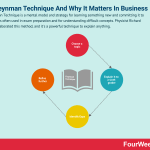

The Feynman Technique is a mental model and strategy for learning something new and committing it to memory. It is often used in exam preparation and for understanding difficult concepts. Physicist Richard Feynman elaborated this method, and it’s a powerful technique to explain anything.
Understanding the Feynman techniqueThe Feynman technique is named after Nobel prize-winning physicist Richard Feynman, who developed the technique to understand a topic in its entirety.
There are four steps to the technique:
Pick a topic that you want to understand completely. Although Feynman used the technique to study physics, it can be used for any topic.Once you think you have an adequate understanding, explain it to someone else as if they were a grade 6 student. The use of plain and simple language is key.If there are gaps in the explanation or if you resort to technical terms, go back to the source material to better understand it.Review what you have learned and then repeat the process from step 2. Importantly, the concept must be understood by a person with no prior base knowledge on the topic.The premise behind the Feynman technique is that to explain something well, one must have the ability to explain it simply.
Indeed, the technique is often associated with the famous Albert Einstein quote: “If you can’t explain it simply, you don’t understand it well enough.”
Benefits of the Feynman technique for businessesIn addition to grasping difficult concepts, there are several other benefits to the Feynman technique.
Identifies gaps in knowledgeThrough the evaluative four-step process, it is inevitable that knowledge gaps will be present themselves.
Identifying and then addressing knowledge gaps strengthens the understanding of both the teacher and the student.
Businesses can also identify certain gaps in their marketing and communication strategies and adjust accordingly.
For example, they should be able to concisely communicate company values and product benefits if asked to do so.
Removing knowledge gaps also ensures that all employees, regardless of role or department, are aware of company and product values.
Useful in communicating traditionally text-heavy, complex ideasThe Feynman Technique is also useful for those who prefer not to write. Feynman himself was a fan of communicating his ideas through the spoken word.
He also used somewhat cartoonish diagrams to communicate complex scientific ideas and tell stories that the average person could relate to.
Organizations that sell complex ideas by necessity, such as stock market investment firms, may find the Feynman technique useful in attracting clients.
Improves teaching skillsThe teachable course industry in the United States is predicted to grow to $325 billion by 2025.
Businesses who operate in this space can use the Feynman Technique to successfully communicate major course ideas and themes to a wide and varied audience.
This gives them a competitive advantage over others and strengthens their position as experts in their industry.
Feynman technique examplesTo conclude this article on the Feynman technique, we will explain how it can be applied to some easily relatable examples.
Learning SpanishYou can use the Feynman technique to not only learn a new language but also understand the intricacies of the language itself.
Suppose you’re employed by a global firm that wants you to relocate to Spain and take up a new role.
The employee starts by listing what they already know about the topic:
In Spanish as in French, noun usage is dictated by gender.In the vast majority of cases, masculine nouns end in “o” and feminine nouns in “a”.Articles also vary according to gender.The individual then writes the following statement as if they were describing Spanish to a young child:
“All nouns have a gender in Spanish. For example, el teléfono (the telephone) is a boy and la mesa (the table) is a girl. Most of the time, you can use the last letter of the noun to tell its gender. Nouns that end in “o” mean it’s a boy, while nouns that end in “a” mean it’s a girl.”
Once the employee reads the statement to their 8-year-old daughter, she asks for clarification on gender, nouns, and articles.
With youthful curiosity, she also wonders how one can tell the gender of an object just by looking at its article.
In the final step, the individual refines his explanation with the following clarifications:
Every object in the Spanish language is either a boy or a girl. We call this gender.Objects, people, place names, and many other things are nouns. Table, telephone, and New York City are all examples of nouns.In Spanish, articles are words that come before the noun. “La” is the article used for feminine (girl) nouns, while “el” is the article used for masculine (boy) nouns. Now you have two ways to tell the gender of an object.It’s also important to remember that in Spanish, a table is simply not mesa but la mesa. Pythagorean TheoremIn the second example, a mathematics teacher uses the technique to find a simple way to explain the Pythagorean Theorem to their students.
On a sheet of paper, the teacher starts with a simple explanation of the theorem which reads as follows:
“For any right angled triangle, you find the squared length of the hypotenuse (this is the longest side) by adding the squared lengths of the other two sides. Formula: A2 + B2 = C2 with C equalling the length of the hypotenuse in the measurement chosen”
Below this description, the teacher draws a diagram of a right-angled triangle and includes a sample calculation.
To make the concept simpler to understand, they ensure that the length of the hypotenuse is a perfect square. In other words, a number whose square root yields a whole number without decimal points.
CSS box modelSuppose we have an amateur coder who wants to review the CSS box model before offering website-building services to clients. The code starts with the following description:
“Every HTML element (images, paragraphs, headings, divs) is contained within a box. When one alters the properties of this box, one can control the amount of white space around the element and how its border works. One can then use this information as the basis for the layout of a webpage.”
The coder then draws a basic diagram of a CSS box, labels it with the four components, and provides a brief explanation for each:
Content box – the area where content is displayed that can be sized using the dimensions width and height. Note to self: padding, border, and margin are added to these dimensions (not included).Padding box – the white space between an element and its border.Border box – may be visible or invisible and wraps the content and any padding. Width and style can also be altered.Margin box – the outermost space between the border and margin edge of the next element. The margin box wraps the content, padding, and border boxes.Like the employee who wants to learn Spanish and the maths teacher that wants to explain the work of Pythagoras, the coder then explains his understanding of the topic to a child and moves through the same process of identifying knowledge gaps and simplification.
Key takeaways:The Feynman technique is a strategy for learning a new concept and memorizing it to the extent that it can be explained to others in plain, simple language.The Feynman technique comprises four steps, with the primary objective being to describe a concept to a person with no prior knowledge in that concept.The Feynman technique has several benefits for businesses. It allows then to identify gaps in operations while also communicating complex ideas to colleagues, potential clients, and customers.Connected Thinking Tools First-principles thinking – sometimes called reasoning from first principles – is used to reverse-engineer complex problems and encourage creativity. It involves breaking down problems into basic elements and reassembling them from the ground up. Elon Musk is among the strongest proponents of this way of thinking.
First-principles thinking – sometimes called reasoning from first principles – is used to reverse-engineer complex problems and encourage creativity. It involves breaking down problems into basic elements and reassembling them from the ground up. Elon Musk is among the strongest proponents of this way of thinking.  The Six Thinking Hats model was created by psychologist Edward de Bono in 1986, who noted that personality type was a key driver of how people approached problem-solving. For example, optimists view situations differently from pessimists. Analytical individuals may generate ideas that a more emotional person would not, and vice versa.
The Six Thinking Hats model was created by psychologist Edward de Bono in 1986, who noted that personality type was a key driver of how people approached problem-solving. For example, optimists view situations differently from pessimists. Analytical individuals may generate ideas that a more emotional person would not, and vice versa.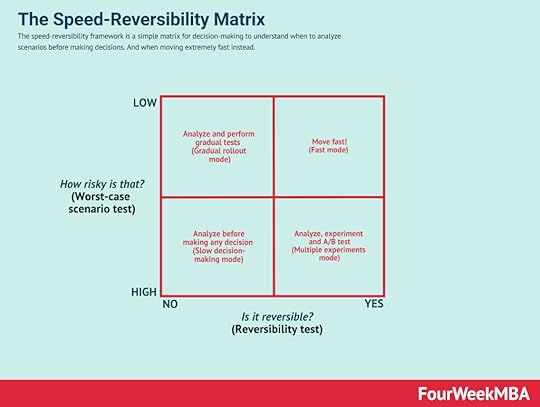
 The ladder of inference is a conscious or subconscious thinking process where an individual moves from a fact to a decision or action. The ladder of inference was created by academic Chris Argyris to illustrate how people form and then use mental models to make decisions.
The ladder of inference is a conscious or subconscious thinking process where an individual moves from a fact to a decision or action. The ladder of inference was created by academic Chris Argyris to illustrate how people form and then use mental models to make decisions.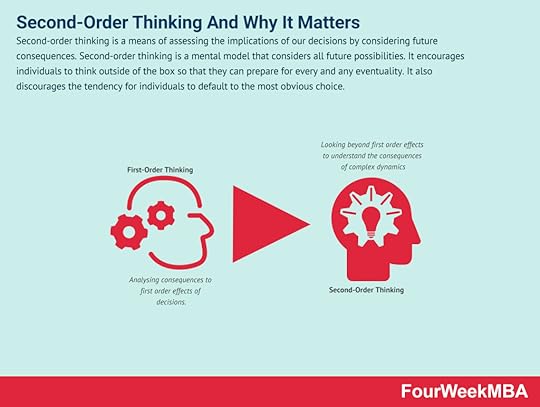 Second-order thinking is a means of assessing the implications of our decisions by considering future consequences. Second-order thinking is a mental model that considers all future possibilities. It encourages individuals to think outside of the box so that they can prepare for every and any eventuality. It also discourages the tendency for individuals to default to the most obvious choice.
Second-order thinking is a means of assessing the implications of our decisions by considering future consequences. Second-order thinking is a mental model that considers all future possibilities. It encourages individuals to think outside of the box so that they can prepare for every and any eventuality. It also discourages the tendency for individuals to default to the most obvious choice. Moonshot thinking is an approach to innovation, and it can be applied to business or any other discipline where you target at least 10X goals. That shifts the mindset, and it empowers a team of people to look for unconventional solutions, thus starting from first principles, by leveraging on fast-paced experimentation.
Moonshot thinking is an approach to innovation, and it can be applied to business or any other discipline where you target at least 10X goals. That shifts the mindset, and it empowers a team of people to look for unconventional solutions, thus starting from first principles, by leveraging on fast-paced experimentation.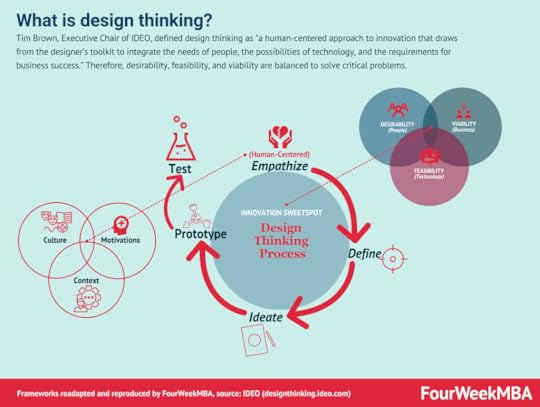 Tim Brown, Executive Chair of IDEO, defined design thinking as “a human-centered approach to innovation that draws from the designer’s toolkit to integrate the needs of people, the possibilities of technology, and the requirements for business success.” Therefore, desirability, feasibility, and viability are balanced to solve critical problems.
Tim Brown, Executive Chair of IDEO, defined design thinking as “a human-centered approach to innovation that draws from the designer’s toolkit to integrate the needs of people, the possibilities of technology, and the requirements for business success.” Therefore, desirability, feasibility, and viability are balanced to solve critical problems. 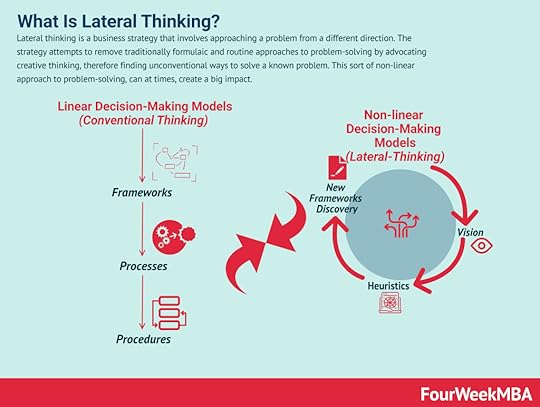 Lateral thinking is a business strategy that involves approaching a problem from a different direction. The strategy attempts to remove traditionally formulaic and routine approaches to problem-solving by advocating creative thinking, therefore finding unconventional ways to solve a known problem. This sort of non-linear approach to problem-solving, can at times, create a big impact.
Lateral thinking is a business strategy that involves approaching a problem from a different direction. The strategy attempts to remove traditionally formulaic and routine approaches to problem-solving by advocating creative thinking, therefore finding unconventional ways to solve a known problem. This sort of non-linear approach to problem-solving, can at times, create a big impact.Learn also:
Speed-Reversibility MatrixGrowth-Share MatrixAnsoff MatrixDigital Strategy MatrixLearn more:
Distribution ChannelsTypes of Business Models You Need to KnowBusiness Strategy: Definition, Examples, And Case StudiesMarketing Strategy: Definition, Types, And ExamplesPlatform Business Models In A NutshellNetwork Effects In A NutshellGross Margin In A NutshellWhat Is Active Listening? Active Listening In A Nutshell
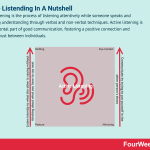

Active listening is the process of listening attentively while someone speaks and displaying understanding through verbal and non-verbal techniques. Active listening is a fundamental part of good communication, fostering a positive connection and building trust between individuals.
Understanding active listeningIn defining active listening, it is useful to describe the difference between listening and hearing.
Listening means receiving sounds with deliberate intention and is an active skill that improves through conscious effort and practice. Hearing, on the other hand, is a passive act involving the process and function of perceiving sound.
The individual who hears without listening has little interest in what another person has to say. They may simply be bored of the conversation or be actively forming a counterargument for when it is their turn to speak.
Active listening goes hand in hand with good communication. Expressing thoughts, feelings, and opinions effectively can only be achieved by truly listening to the thoughts, feelings, and opinions of the speaker.
Furthermore, a speaker who has the listener’s undivided attention is more likely to feel heard, understood, and accepted. For this reason, active listening builds trust and fosters a deep connection between individuals.
Non-verbal active listening techniquesFollowing is a generic list of non-verbal techniques that may or may not be representative of active listening:
Smiling combined with nodding of the head – this shows the speaker the listener is paying attention to what is being said. It is also confirmation the listener understands and is happy about the messages conveyed. Eye contact – too much eye contact comes across as disingenuous, while too little shows a lack of interest. Listeners should always strive for somewhere in between, matching their level of eye contact to the confidence of the speaker. Eye contact can be combined with other non-verbal signals for encouragement.Posture – active listeners lean forward slightly or sit sideways. Some may also rest the head on one hand.Mirroring – or the process of imitating the facial expressions or posture of the speaker. Studies have shown that mirroring is a human bonding mechanism and can be used to show empathy during emotional conversations.Verbal active listening techniquesNow that we’ve covered non-verbal techniques, let’s take a look at some verbal strategies:
Paraphrasing (summarisation) – this means the listener restates the information given by the speaker in their own words. Paraphrasing demonstrates to the speaker that their message has been listened to and understood. It also allows the listener to clarify their understanding of the message if unsure. Open-ended questions – or any question that cannot be answered with a ‘yes’ or ‘no’. Open-ended questions encourage the speaker to expand on a topic and let them know their ideas matter to the listener. It also relaxes nervous speakers since most people are quite comfortable talking about themselves and what matters to them most. Positive reinforcement – if used sparingly, positive reinforcement encourages the speaker to continue. Frequent use of words such as ‘yes’ or ‘indeed’ should be avoided. Instead, the listener should elaborate on why they are supportive of a particular point.Sharing similar experiences – when the listener shares a comparable experience, it lets the speaker know their message has been interpreted successfully. Shared experiences also encourage strong relationships to form. Recalling previously shared information – while the listener should never take notes during a conversation, it is worth mentioning concepts, ideas, or other points from a previous conversation. This is a good way to show the speaker that their words were listened to and made a lasting impression.Active listening examplesHere are a few examples of active listening to shed some light on how it may be embodied in practice.
For this section, we’ll provide both verbal and non-verbal examples across various techniques.
Verbal active listening examplesParaphrasing (summarisation)– “So if I understand you correctly, the content management system you are using at present does not meet your business needs because it fails to provide support for large images and videos.”Open-ended questions – “You are correct when you state that the customer checkout process could be updated. What are some of the changes you envisage making to the process over the next quarter?”Sharing similar experiences – “In a previous role, I also found this accounting software problematic. But once I overcame the steep learning curve and acquainted myself with all the features, I found that it was much easier to use.”Recall previously shared information – “In one of our discussions a few weeks ago, you mentioned that you were to looking to add more experience to the project management team. I can see that this move has been beneficial for the organization!”Displaying empathy – “I’m truly sorry that the video projector failed in the middle of an important presentation. Let’s work together to determine how I can help you avoid this scenario in the future.”Building trust and rapport – “Let me know what I can do to help. I had a detailed look over your website and was impressed to discover that you donate 5% of sales revenue to environmental organizations.”Non-verbal active listening examplesNod – in a sales presentation, the audience nods periodically at the speaker to show they understand what is being communicated to them. Nod and smile – When a nod is combined with a smile in the same scenario as above, audience members not only practice active listening but also show that they agree with the presentation’s content or broader message. Avoiding any actions which imply distraction – now imagine a scenario where a company is listening to a prospective client describe its pain points to them for the first time. The company representative remains still to communicate that they are focussed on what the prospect is saying. In other words, they do not fidget, look idly around the room, shift in their seat demonstrably, play with their hair, check their smartphone, or tap their pen against the desk. Posture – further to the example above, the company representative leans forward a touch when listening to the prospect’s pain points. They may also choose to sit slightly sideways and, in some cases, may rest their head against one hand.Mirroring – sticking with the sales meeting between a prospect and client, the company rep notices that the prospect leans back as they talk and sometimes crosses their arms. To increase trust and build rapport, the rep does the same in a way that is subtle and unlikely to cause offence. Whilst not their natural style, the rep also strives to match the prospect’s friendly and excitable tone of voice.Key takeaways:Active listening is the process of listening attentively while someone speaks. It is distinct from the process of hearing which is passive and typically occurs in a distracted state.Active listening is a fundamental part of good communication, fostering a positive connection and building trust between individuals.Active listening can be supported by various non-verbal and verbal techniques. These include smiling, eye contact, mirroring, positive reinforcement, paraphrasing, and the asking of open-ended questions.Connected Business Concepts To Active Listening The Spotify Model is an autonomous approach to scaling agile, focusing on culture communication, accountability, and quality. The Spotify model was first recognized in 2012 after Henrik Kniberg, and Anders Ivarsson released a white paper detailing how streaming company Spotify approached agility. Therefore, the Spotify model represents an evolution of agile.
The Spotify Model is an autonomous approach to scaling agile, focusing on culture communication, accountability, and quality. The Spotify model was first recognized in 2012 after Henrik Kniberg, and Anders Ivarsson released a white paper detailing how streaming company Spotify approached agility. Therefore, the Spotify model represents an evolution of agile. 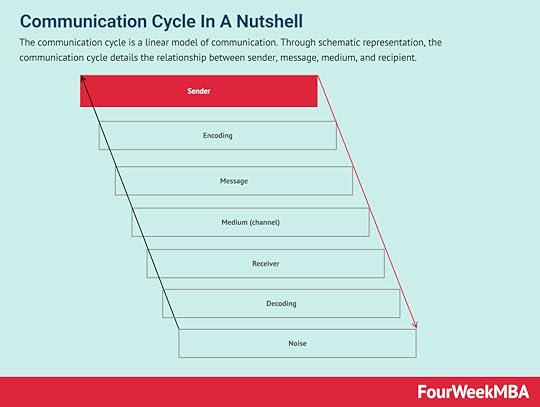 The communication cycle is a linear model of communication. Through schematic representation, the communication cycle details the relationship between sender, message, medium, and recipient.
The communication cycle is a linear model of communication. Through schematic representation, the communication cycle details the relationship between sender, message, medium, and recipient. A communication strategy framework clarifies how businesses should communicate with their employees, investors, customers, and suppliers. Some of the key elements of an effective communication strategy move around purpose, background, objectives, target audience, messaging, and approach.
A communication strategy framework clarifies how businesses should communicate with their employees, investors, customers, and suppliers. Some of the key elements of an effective communication strategy move around purpose, background, objectives, target audience, messaging, and approach.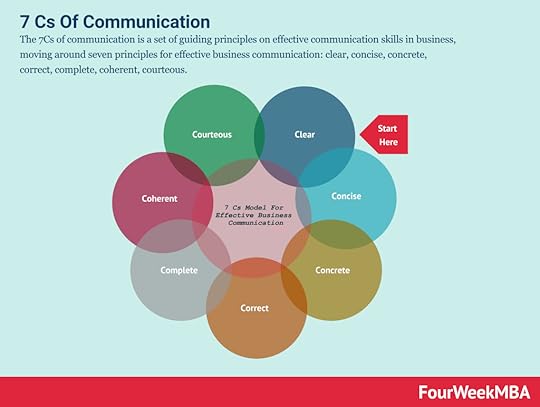 The 7Cs of communication is a set of guiding principles on effective communication skills in business, moving around seven principles for effective business communication: clear, concise, concrete, correct, complete, coherent, courteous.
The 7Cs of communication is a set of guiding principles on effective communication skills in business, moving around seven principles for effective business communication: clear, concise, concrete, correct, complete, coherent, courteous.  To optimize its marketing communications, a business can categorize media as either paid, earned, shared, or owned media (PESO). Analyzing these four categories is particularly useful for content-driven, online marketing strategies to build brand awareness, customer loyalty, and gain market share.
To optimize its marketing communications, a business can categorize media as either paid, earned, shared, or owned media (PESO). Analyzing these four categories is particularly useful for content-driven, online marketing strategies to build brand awareness, customer loyalty, and gain market share. The brand voice describes how a brand communicates with its target audience. The exact style of communication is based on the brand persona or the collection of personality traits and values that a brand embodies regularly, and it needs to communicate the brand’s essence to the desired target audience.
The brand voice describes how a brand communicates with its target audience. The exact style of communication is based on the brand persona or the collection of personality traits and values that a brand embodies regularly, and it needs to communicate the brand’s essence to the desired target audience.Main Free Guides:
Business ModelsBusiness StrategyBusiness DevelopmentDigital Business ModelsDistribution ChannelsMarketing StrategyPlatform Business ModelsTech Business ModelSeptember 18, 2022
27 Blockchain Frameworks You Need To Know!
 Web3 describes a version of the internet where data will be interconnected in a decentralized way. Web3 is an umbrella that comprises various fields like semantic web, AR/VR, AI at scale, blockchain technologies, and decentralization. The core idea of Web3 moves along the lines of enabling decentralized ownership on the web.
Blockchain Protocol
Web3 describes a version of the internet where data will be interconnected in a decentralized way. Web3 is an umbrella that comprises various fields like semantic web, AR/VR, AI at scale, blockchain technologies, and decentralization. The core idea of Web3 moves along the lines of enabling decentralized ownership on the web.
Blockchain Protocol
 A blockchain protocol is a set of underlying rules that define how a blockchain will work. Based on the underlying rules of the protocol it’s possible to build a business ecosystem. Usually, protocol’s rules comprise everything from how tokens can be issued, how value is created, and how interactions happen on top of the protocol.
Hard Fork
A blockchain protocol is a set of underlying rules that define how a blockchain will work. Based on the underlying rules of the protocol it’s possible to build a business ecosystem. Usually, protocol’s rules comprise everything from how tokens can be issued, how value is created, and how interactions happen on top of the protocol.
Hard Fork
 In software engineering, a fork consists of a “split” of a project, as developers take the source code to start independently developing on it. Software protocols (the set of rules underlying the software) usually fork as a group decision-making process. All developers have to agree on the new course and direction of the software protocol. A fork can be “soft” when an alteration to the software protocol keeps it backward compatible or “hard” where a divergence of the new chain is permanent. Forks are critical to the development and evolution of Blockchain protocols.
Merkle Tree
In software engineering, a fork consists of a “split” of a project, as developers take the source code to start independently developing on it. Software protocols (the set of rules underlying the software) usually fork as a group decision-making process. All developers have to agree on the new course and direction of the software protocol. A fork can be “soft” when an alteration to the software protocol keeps it backward compatible or “hard” where a divergence of the new chain is permanent. Forks are critical to the development and evolution of Blockchain protocols.
Merkle Tree
 A Merkle tree is a data structure encoding blockchain data more efficiently and securely. The Merkle tree is one of the foundational components of a Blockchain protocol.
Nothing-at-stake
A Merkle tree is a data structure encoding blockchain data more efficiently and securely. The Merkle tree is one of the foundational components of a Blockchain protocol.
Nothing-at-stake
 The nothing-at-stake problem argues that validators on a blockchain with a financial incentive to mine on each fork are disruptive to consensus. Potentially, this makes the system more vulnerable to attack. This is a key problem that makes possible underlying blockchain protocols, based on core mechanisms like a proof-of-stake consensus, a key consensus system, that together the proof-of-work make up key protocols like Bitcoin and Ethereum.
51% Attack
The nothing-at-stake problem argues that validators on a blockchain with a financial incentive to mine on each fork are disruptive to consensus. Potentially, this makes the system more vulnerable to attack. This is a key problem that makes possible underlying blockchain protocols, based on core mechanisms like a proof-of-stake consensus, a key consensus system, that together the proof-of-work make up key protocols like Bitcoin and Ethereum.
51% Attack
 A 51% Attack is an attack on the blockchain network by an entity or organization. The primary goal of such an attack is the exclusion or modification of blockchain transactions. A 51% attack is carried out by a miner or group of miners endeavoring to control more than half of a network’s mining power, hash rate, or computing power. For this reason, it is sometimes called a majority attack. This can corrupt a blockchain protocol that malicious attackers would take over.
Proof of Work
A 51% Attack is an attack on the blockchain network by an entity or organization. The primary goal of such an attack is the exclusion or modification of blockchain transactions. A 51% attack is carried out by a miner or group of miners endeavoring to control more than half of a network’s mining power, hash rate, or computing power. For this reason, it is sometimes called a majority attack. This can corrupt a blockchain protocol that malicious attackers would take over.
Proof of Work
 A Proof of Work is a form of consensus algorithm used to achieve agreement across a distributed network. In a Proof of Work, miners compete to complete transactions on the network, by commuting hard mathematical problems (i.e. hashes functions) and as a result they get rewarded in coins.
Application Binary Interface
A Proof of Work is a form of consensus algorithm used to achieve agreement across a distributed network. In a Proof of Work, miners compete to complete transactions on the network, by commuting hard mathematical problems (i.e. hashes functions) and as a result they get rewarded in coins.
Application Binary Interface
 An Application Binary Interface (ABI) is the interface between two binary program modules that work together. An ABI is a contract between pieces of binary code defining the mechanisms by which functions are invoked and how parameters are passed between the caller and callee. ABIs have become critical in the development of applications leveraging smart contracts, on Blockchain protocols like Ethereum.
Proof of Stake
An Application Binary Interface (ABI) is the interface between two binary program modules that work together. An ABI is a contract between pieces of binary code defining the mechanisms by which functions are invoked and how parameters are passed between the caller and callee. ABIs have become critical in the development of applications leveraging smart contracts, on Blockchain protocols like Ethereum.
Proof of Stake
 A Proof of Stake (PoS) is a form of consensus algorithm used to achieve agreement across a distributed network. As such it is, together with Proof of Work, among the key consensus algorithms for Blockchain protocols (like the Ethereum’s Casper protocol). Proof of Stake has the advantage of security, reduced risk of centralization, and energy efficiency.
Proof of Work vs. Proof of Stake
A Proof of Stake (PoS) is a form of consensus algorithm used to achieve agreement across a distributed network. As such it is, together with Proof of Work, among the key consensus algorithms for Blockchain protocols (like the Ethereum’s Casper protocol). Proof of Stake has the advantage of security, reduced risk of centralization, and energy efficiency.
Proof of Work vs. Proof of Stake

 Proof-of-Activity (PoA) is a blockchain consensus algorithm that facilitates genuine transactions and consensus amongst miners. That is a consensus algorithm combining proof-of-work and proof-of-stake. This consensus algorithm is designed to prevent attacks on the underlying Blockchain.
Blockchain Economics
Proof-of-Activity (PoA) is a blockchain consensus algorithm that facilitates genuine transactions and consensus amongst miners. That is a consensus algorithm combining proof-of-work and proof-of-stake. This consensus algorithm is designed to prevent attacks on the underlying Blockchain.
Blockchain Economics
 According to Joel Monegro, a former analyst at USV (a venture capital firm) the blockchain implies value creation in its protocols. Where the web has allowed the value to be captured at the applications layer (take Facebook, Twitter, Google, and many others). In a Blockchain Economy, this value might be captured by the protocols at the base of the blockchain (for instance Bitcoin and Ethereum).
Blockchain Business Model Framework
According to Joel Monegro, a former analyst at USV (a venture capital firm) the blockchain implies value creation in its protocols. Where the web has allowed the value to be captured at the applications layer (take Facebook, Twitter, Google, and many others). In a Blockchain Economy, this value might be captured by the protocols at the base of the blockchain (for instance Bitcoin and Ethereum).
Blockchain Business Model Framework
 A Blockchain Business Model is made of four main components: Value Model (Core Philosophy, Core Value and Value Propositions for the key stakeholders), Blockchain Model (Protocol Rules, Network Shape and Applications Layer/Ecosystem), Distribution Model (the key channels amplifying the protocol and its communities), and the Economic Model (the dynamics through which protocol players make money). Those elements coming together can serve as the basis to build and analyze a solid Blockchain Business Model.
Sharding
A Blockchain Business Model is made of four main components: Value Model (Core Philosophy, Core Value and Value Propositions for the key stakeholders), Blockchain Model (Protocol Rules, Network Shape and Applications Layer/Ecosystem), Distribution Model (the key channels amplifying the protocol and its communities), and the Economic Model (the dynamics through which protocol players make money). Those elements coming together can serve as the basis to build and analyze a solid Blockchain Business Model.
Sharding
 Blockchain companies use sharding to partition databases and increase scalability, allowing them to process more transactions per second. Sharding is a key mechanism underneath the Ethereum Blockchain and one of its critical components. Indeed, sharding enables Blockchain protocols to overcome the Scalability Trilemma (as a Blockchain grows, it stays scalable, secure, and decentralized).
DAO
Blockchain companies use sharding to partition databases and increase scalability, allowing them to process more transactions per second. Sharding is a key mechanism underneath the Ethereum Blockchain and one of its critical components. Indeed, sharding enables Blockchain protocols to overcome the Scalability Trilemma (as a Blockchain grows, it stays scalable, secure, and decentralized).
DAO
 A decentralized autonomous organization (DAO) operates autonomously on blockchain protocol under rules governed by smart contracts. DAO is among the most important innovations that Blockchain has brought to the business world, which can create “super entities” or large entities that do not have a central authority but are instead managed in a decentralized manner.
Smart Contracts
A decentralized autonomous organization (DAO) operates autonomously on blockchain protocol under rules governed by smart contracts. DAO is among the most important innovations that Blockchain has brought to the business world, which can create “super entities” or large entities that do not have a central authority but are instead managed in a decentralized manner.
Smart Contracts
 Smart contracts are protocols designed to facilitate, verify, or enforce digital contracts without the need for a credible third party. These contracts work on an “if/when-then” principle and have some similarities to modern escrow services but without a third party involved in guaranteeing the transaction. Instead, it uses blockchain technology to verify the information and increase trust between the transaction participants.
Non-Fungible Tokens
Smart contracts are protocols designed to facilitate, verify, or enforce digital contracts without the need for a credible third party. These contracts work on an “if/when-then” principle and have some similarities to modern escrow services but without a third party involved in guaranteeing the transaction. Instead, it uses blockchain technology to verify the information and increase trust between the transaction participants.
Non-Fungible Tokens
 Non-fungible tokens (NFTs) are cryptographic tokens that represent something unique. Non-fungible assets are those that are not mutually interchangeable. Non-fungible tokens contain identifying information that makes them unique. Unlike Bitcoin – which has a supply of 21 million identical coins – they cannot be exchanged like for like.
Decentralized Finance
Non-fungible tokens (NFTs) are cryptographic tokens that represent something unique. Non-fungible assets are those that are not mutually interchangeable. Non-fungible tokens contain identifying information that makes them unique. Unlike Bitcoin – which has a supply of 21 million identical coins – they cannot be exchanged like for like.
Decentralized Finance
 Decentralized finance (DeFi) refers to an ecosystem of financial products that do not rely on traditional financial intermediaries such as banks and exchanges. Central to the success of decentralized finance is smart contracts, which are deployed on Ethereum (contracts that two parties can deploy without an intermediary). DeFi also gave rise to dApps (decentralized apps), giving developers the ability to build applications on top of the Ethereum blockchain.
History of Bitcoin
Decentralized finance (DeFi) refers to an ecosystem of financial products that do not rely on traditional financial intermediaries such as banks and exchanges. Central to the success of decentralized finance is smart contracts, which are deployed on Ethereum (contracts that two parties can deploy without an intermediary). DeFi also gave rise to dApps (decentralized apps), giving developers the ability to build applications on top of the Ethereum blockchain.
History of Bitcoin
 The history of Bitcoin starts before the 2008 White Paper by Satoshi Nakamoto. In 1989 first and 1991, David Chaum created DigiCash, and various cryptographers tried to solve the “double spending” problem. By 1998 Nick Szabo began working on a decentralized digital currency called “bit gold.” By 2008 the Bitcoin White Paper got published. And from there, by 2014, the Blockchain 2.0 (beyond the money use case) sprouted out.
Altcoins
The history of Bitcoin starts before the 2008 White Paper by Satoshi Nakamoto. In 1989 first and 1991, David Chaum created DigiCash, and various cryptographers tried to solve the “double spending” problem. By 1998 Nick Szabo began working on a decentralized digital currency called “bit gold.” By 2008 the Bitcoin White Paper got published. And from there, by 2014, the Blockchain 2.0 (beyond the money use case) sprouted out.
Altcoins
 An altcoin is a general term describing any cryptocurrency other than Bitcoin. Indeed, as Bitcoin started to evolve since its inception, back in 2009, many other cryptocurrencies sprouted due to philosophical differences with the Bitcoin protocol but also to cover wider use cases that the Bitcoin protocol could enable.
Ethereum
An altcoin is a general term describing any cryptocurrency other than Bitcoin. Indeed, as Bitcoin started to evolve since its inception, back in 2009, many other cryptocurrencies sprouted due to philosophical differences with the Bitcoin protocol but also to cover wider use cases that the Bitcoin protocol could enable.
Ethereum
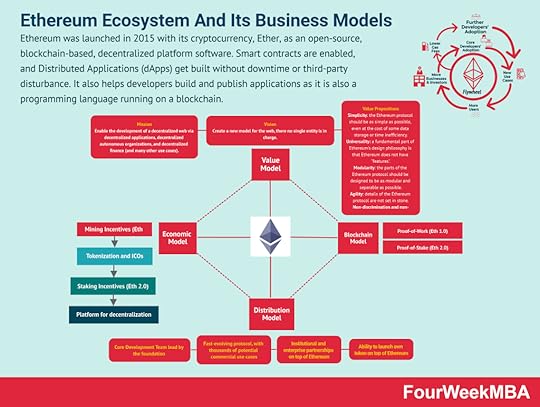 Ethereum was launched in 2015 with its cryptocurrency, Ether, as an open-source, blockchain-based, decentralized platform software. Smart contracts are enabled, and Distributed Applications (dApps) get built without downtime or third-party disturbance. It also helps developers build and publish applications as it is also a programming language running on a blockchain.
Ethereum Flywheel
Ethereum was launched in 2015 with its cryptocurrency, Ether, as an open-source, blockchain-based, decentralized platform software. Smart contracts are enabled, and Distributed Applications (dApps) get built without downtime or third-party disturbance. It also helps developers build and publish applications as it is also a programming language running on a blockchain.
Ethereum Flywheel
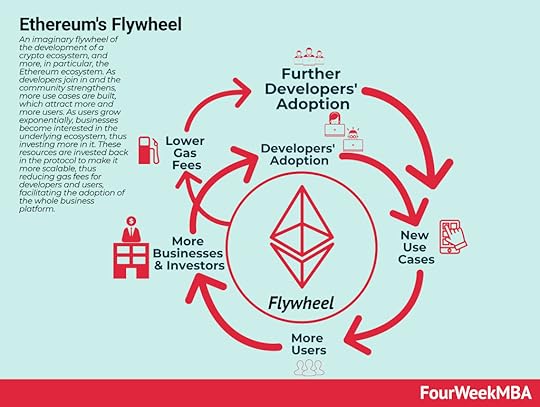 An imaginary flywheel of the development of a crypto ecosystem, and more, in particular, the Ethereum ecosystem. As developers join in and the community strengthens, more use cases are built, which attract more and more users. As users grow exponentially, businesses become interested in the underlying ecosystem, thus investing more in it. These resources are invested back in the protocol to make it more scalable, thus reducing gas fees for developers and users, facilitating the adoption of the whole business platform.
Solana
An imaginary flywheel of the development of a crypto ecosystem, and more, in particular, the Ethereum ecosystem. As developers join in and the community strengthens, more use cases are built, which attract more and more users. As users grow exponentially, businesses become interested in the underlying ecosystem, thus investing more in it. These resources are invested back in the protocol to make it more scalable, thus reducing gas fees for developers and users, facilitating the adoption of the whole business platform.
Solana
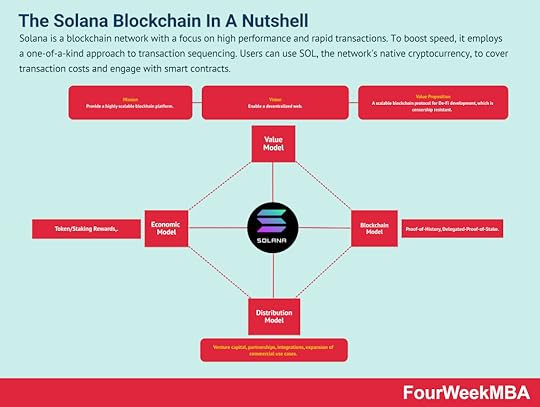 Solana is a blockchain network with a focus on high performance and rapid transactions. To boost speed, it employs a one-of-a-kind approach to transaction sequencing. Users can use SOL, the network’s native cryptocurrency, to cover transaction costs and engage with smart contracts.
Polkadot
Solana is a blockchain network with a focus on high performance and rapid transactions. To boost speed, it employs a one-of-a-kind approach to transaction sequencing. Users can use SOL, the network’s native cryptocurrency, to cover transaction costs and engage with smart contracts.
Polkadot
 In essence, Polkadot is a cryptocurrency project created as an effort to transform and power a decentralized internet, Web 3.0, in the future. Polkadot is a decentralized platform, which makes it interoperable with other blockchains.
Filecoin
In essence, Polkadot is a cryptocurrency project created as an effort to transform and power a decentralized internet, Web 3.0, in the future. Polkadot is a decentralized platform, which makes it interoperable with other blockchains.
Filecoin
 Launched in October 2020, Filecoin protocol is based on a “useful work” consensus, where the miners are rewarded as they perform useful work for the network (provide storage and retrieve data). Filecoin (⨎) is an open-source, public cryptocurrency and digital payment system. Built on the InterPlanetary File System.
Brave
Launched in October 2020, Filecoin protocol is based on a “useful work” consensus, where the miners are rewarded as they perform useful work for the network (provide storage and retrieve data). Filecoin (⨎) is an open-source, public cryptocurrency and digital payment system. Built on the InterPlanetary File System.
Brave
 BAT or Basic Attention Token is a utility token aiming to provide privacy-based web tools for advertisers and users to monetize attention on the web in a decentralized way via Blockchain-based technologies. Therefore, the BAT ecosystem moves around a browser (Brave), a privacy-based search engine (Brave Search), and a utility token (BAT). Users can opt-in to advertising, thus making money based on their attention to ads as they browse the web.
Decentralized Exchange
BAT or Basic Attention Token is a utility token aiming to provide privacy-based web tools for advertisers and users to monetize attention on the web in a decentralized way via Blockchain-based technologies. Therefore, the BAT ecosystem moves around a browser (Brave), a privacy-based search engine (Brave Search), and a utility token (BAT). Users can opt-in to advertising, thus making money based on their attention to ads as they browse the web.
Decentralized Exchange
 Uniswap is a renowned decentralized crypto exchange created in 2018 and based on the Ethereum blockchain, to provide liquidity to the system. As a cryptocurrency exchange technology that operates on a decentralized basis. The Uniswap protocol inherited its namesake from the business that created it — Uniswap. Through smart contracts, the Uniswap protocol automates transactions between cryptocurrency tokens on the Ethereum blockchain.
Uniswap is a renowned decentralized crypto exchange created in 2018 and based on the Ethereum blockchain, to provide liquidity to the system. As a cryptocurrency exchange technology that operates on a decentralized basis. The Uniswap protocol inherited its namesake from the business that created it — Uniswap. Through smart contracts, the Uniswap protocol automates transactions between cryptocurrency tokens on the Ethereum blockchain.Read Next: Proof-of-stake, Proof-of-work, Bitcoin, Ethereum, Blockchain.
The post 27 Blockchain Frameworks You Need To Know! appeared first on FourWeekMBA.
September 16, 2022
Founder-Problem Fit
Founder-Problem Fit, as defined by Roelof Botha, partner at Sequoia, is a situation where the founder is fully committed to solving a hard problem. So much so that the founder can overcome any obstacle to make her/his idea work, nonetheless of the struggle required.
Breaking down Founder-Problem FitWhen it comes to disruptive business models, the more you try to solve a very hard problem, the more it requires a willingness to go through hard times, uncertainty, and survival threats for your startup.
This is not for everyone.
That is also why founders are so celebrated; if they weren’t, things would be even harder.
In short, the fame and attention that you get as a founder might attract some narcissists, of course, but overall also enables more people to build people and become entrepreneurs.
Only in the last decades the figure of the entrepreneur has become central to the public discourse.
So for this newsletter issue, I’d like to ponder a concept based on the personal ability of the founder to keep going, also when everything seems broken and falling apart (which is the norm in Startupland).
Thus, when looking at companies with potential, it’s critical to look at something called Founder-Problem Fit!
As I was listening to the podcast interview by Tim Ferris with Roelof Botha, the partner at Sequoia Capital, Tim Ferris asked what some of the defining characteristics Sequoia has identified over the years about successful founders.
Roelof Botha’s reply was enlightening!
Here you go:
“It starts with an authentic identification with a problem.
I think when that founding inspiration because if you’re trying to start a business for the sake of starting a business, it’s so hard; there are so many challenges on the way to building a successful company.
If you’re doing it for the wrong reasons, you’re going to wilt, you simply won’t persevere.
But if you’re deeply motivated by what you’re doing, you’ll keep going, and you’ll overcome obstacle after obstacle and so that, to me, is one of the key starting conditions.
It is founder-problem fit!”
Roelof Botha continued:
“I love asking a founder, and I meet them like how did you come up with this idea?
Like, what was the eureka moment where something snapped, and you want to do to address this problem?
And what is about the current solutions that you must have evaluated that frustrated you and that you didn’t think was good enough?
And then the next one is: what’s your unique and compelling value proposition so having evaluated alternatives?
And deciding to build something, why do you think what you’re building is so distinct that it has a chance of flourishing and becoming a real business?”
Roelof Botha explained it with a story:
“There’s a founder Matt Rabinowitz he and I met in high school in South Africa in 1987 at a nerd camp.
It was actually called an academic vacation school, but I mean, that’s just a very nice way of saying.
And he’s absolutely brilliant he was a gold medalist in a national science olympiad, he came to Stanford, he studied physics and electrical engineering.
And in 2002, his sister had a baby that died within a week of birth, and he was shocked at the state of prenatal testing, and he went back to Stanford, and he learned everything he could about biology and genetics and started this company in Natera!
I’m still on the board 15 years later, we made a million-dollar seed investment in him in 2006 as just an idea, and today, they deliver millions of tests to help people have healthy families.
But it started with an incredibly authentic inspiration for him which is seeing what his sister had to deal with!”
That is what Founder-Problem Fit stands for!
Read Next: Problem-Solution Fit, Problem-Market Fit.
FourWeekMBA Business Toolbox A tech business model is made of four main components: value model (value propositions, mission, vision), technological model (R&D management), distribution model (sales and marketing organizational structure), and financial model (revenue modeling, cost structure, profitability and cash generation/management). Those elements coming together can serve as the basis to build a solid tech business model.
A tech business model is made of four main components: value model (value propositions, mission, vision), technological model (R&D management), distribution model (sales and marketing organizational structure), and financial model (revenue modeling, cost structure, profitability and cash generation/management). Those elements coming together can serve as the basis to build a solid tech business model.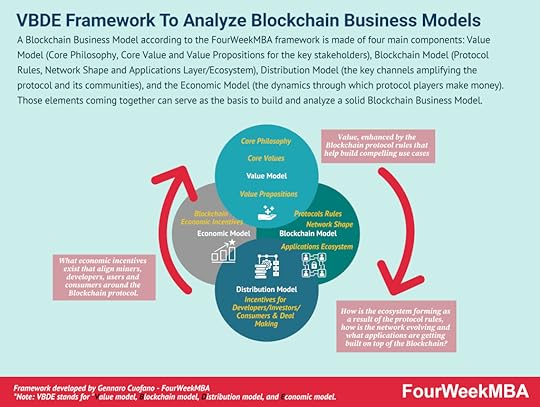 A Blockchain Business Model according to the FourWeekMBA framework is made of four main components: Value Model (Core Philosophy, Core Values and Value Propositions for the key stakeholders), Blockchain Model (Protocol Rules, Network Shape and Applications Layer/Ecosystem), Distribution Model (the key channels amplifying the protocol and its communities), and the Economic Model (the dynamics/incentives through which protocol players make money). Those elements coming together can serve as the basis to build and analyze a solid Blockchain Business Model.
A Blockchain Business Model according to the FourWeekMBA framework is made of four main components: Value Model (Core Philosophy, Core Values and Value Propositions for the key stakeholders), Blockchain Model (Protocol Rules, Network Shape and Applications Layer/Ecosystem), Distribution Model (the key channels amplifying the protocol and its communities), and the Economic Model (the dynamics/incentives through which protocol players make money). Those elements coming together can serve as the basis to build and analyze a solid Blockchain Business Model. In an asymmetric business model, the organization doesn’t monetize the user directly, but it leverages the data users provide coupled with technology, thus have a key customer pay to sustain the core asset. For example, Google makes money by leveraging users’ data, combined with its algorithms sold to advertisers for visibility.
In an asymmetric business model, the organization doesn’t monetize the user directly, but it leverages the data users provide coupled with technology, thus have a key customer pay to sustain the core asset. For example, Google makes money by leveraging users’ data, combined with its algorithms sold to advertisers for visibility.  In a business world driven by technology and digitalization, competition is much more fluid, as innovation becomes a bottom-up approach that can come from anywhere. Thus, making it much harder to define the boundaries of existing markets. Therefore, a proper business competition analysis looks at customer, technology, distribution, and financial model overlaps. While at the same time looking at future potential intersections among industries that in the short-term seem unrelated.
In a business world driven by technology and digitalization, competition is much more fluid, as innovation becomes a bottom-up approach that can come from anywhere. Thus, making it much harder to define the boundaries of existing markets. Therefore, a proper business competition analysis looks at customer, technology, distribution, and financial model overlaps. While at the same time looking at future potential intersections among industries that in the short-term seem unrelated. Technological modeling is a discipline to provide the basis for companies to sustain innovation, thus developing incremental products. While also looking at breakthrough innovative products that can pave the way for long-term success. In a sort of Barbell Strategy, technological modeling suggests having a two-sided approach, on the one hand, to keep sustaining continuous innovation as a core part of the business model. On the other hand, it places bets on future developments that have the potential to break through and take a leap forward.
Technological modeling is a discipline to provide the basis for companies to sustain innovation, thus developing incremental products. While also looking at breakthrough innovative products that can pave the way for long-term success. In a sort of Barbell Strategy, technological modeling suggests having a two-sided approach, on the one hand, to keep sustaining continuous innovation as a core part of the business model. On the other hand, it places bets on future developments that have the potential to break through and take a leap forward. A transitional business model is used by companies to enter a market (usually a niche) to gain initial traction and prove the idea is sound. The transitional business model helps the company secure the needed capital while having a reality check. It helps shape the long-term vision and a scalable business model.
A transitional business model is used by companies to enter a market (usually a niche) to gain initial traction and prove the idea is sound. The transitional business model helps the company secure the needed capital while having a reality check. It helps shape the long-term vision and a scalable business model. The minimum viable audience (MVA) represents the smallest possible audience that can sustain your business as you get it started from a microniche (the smallest subset of a market). The main aspect of the MVA is to zoom into existing markets to find those people which needs are unmet by existing players.
The minimum viable audience (MVA) represents the smallest possible audience that can sustain your business as you get it started from a microniche (the smallest subset of a market). The main aspect of the MVA is to zoom into existing markets to find those people which needs are unmet by existing players. Business scaling is the process of transformation of a business as the product is validated by wider and wider market segments. Business scaling is about creating traction for a product that fits a small market segment. As the product is validated it becomes critical to build a viable business model. And as the product is offered at wider and wider market segments, it’s important to align product, business model, and organizational design, to enable wider and wider scale.
Business scaling is the process of transformation of a business as the product is validated by wider and wider market segments. Business scaling is about creating traction for a product that fits a small market segment. As the product is validated it becomes critical to build a viable business model. And as the product is offered at wider and wider market segments, it’s important to align product, business model, and organizational design, to enable wider and wider scale. The market expansion consists in providing a product or service to a broader portion of an existing market or perhaps expanding that market. Or yet, market expansions can be about creating a whole new market. At each step, as a result, a company scales together with the market covered.
The market expansion consists in providing a product or service to a broader portion of an existing market or perhaps expanding that market. Or yet, market expansions can be about creating a whole new market. At each step, as a result, a company scales together with the market covered.
Asymmetric Betting

 In the FourWeekMBA growth matrix, you can apply growth for existing customers by tackling the same problems (gain mode). Or by tackling existing problems, for new customers (expand mode). Or by tackling new problems for existing customers (extend mode). Or perhaps by tackling whole new problems for new customers (reinvent mode).
In the FourWeekMBA growth matrix, you can apply growth for existing customers by tackling the same problems (gain mode). Or by tackling existing problems, for new customers (expand mode). Or by tackling new problems for existing customers (extend mode). Or perhaps by tackling whole new problems for new customers (reinvent mode). In the FourWeekMBA Revenue Streams Matrix, revenue streams are classified according to the kind of interactions the business has with its key customers. The first dimension is the “Frequency” of interaction with the key customer. As the second dimension, there is the “Ownership” of the interaction with the key customer.
In the FourWeekMBA Revenue Streams Matrix, revenue streams are classified according to the kind of interactions the business has with its key customers. The first dimension is the “Frequency” of interaction with the key customer. As the second dimension, there is the “Ownership” of the interaction with the key customer. Revenue model patterns are a way for companies to monetize their business models. A revenue model pattern is a crucial building block of a business model because it informs how the company will generate short-term financial resources to invest back into the business. Thus, the way a company makes money will also influence its overall business model.
Revenue model patterns are a way for companies to monetize their business models. A revenue model pattern is a crucial building block of a business model because it informs how the company will generate short-term financial resources to invest back into the business. Thus, the way a company makes money will also influence its overall business model. A pricing strategy or model helps companies find the pricing formula in fit with their business models. Thus aligning the customer needs with the product type while trying to enable profitability for the company. A good pricing strategy aligns the customer with the company’s long term financial sustainability to build a solid business model.
A pricing strategy or model helps companies find the pricing formula in fit with their business models. Thus aligning the customer needs with the product type while trying to enable profitability for the company. A good pricing strategy aligns the customer with the company’s long term financial sustainability to build a solid business model.The post Founder-Problem Fit appeared first on FourWeekMBA.
Demand Generation In A Tech-Driven World


In the tech-driven start-up world, we focus a lot on the practical side of things (which is fine), but we overlook the other side: demand generation.
The master of demand generation is Nike, which invented influencer marketing when it didn’t have a name!
Back in the 1970s, Nike closed its first deal.
The company paid $5,000 to distance runner Steve Prefontaine to run with the company’s shoes.
A tiny deal compared to the ones it closes now.
Steve Prefontaine represented the athlete who crystallized the approach that Nike would use later on to generate demand for its products.
Today (as I’ll show you), Nike has scaled this approach, but at the time, it had to re-invent it from scratch, as athletes didn’t know who Nike was (the Nike brand shoe was launched in 1972).
Prefontaine was also a pupil of Nike’s co-founder, Bill Bowerman.
Bill Bowerman was a coach at the University of Oregon; he was the product guy, always experimenting with new shoes and making technology a key component of the shoes.
Bill Bowerman opened the way to technology as a key component to differentiate the product, thus a key element of Nike’s marketing strategy for decades.
Yet, the most staggering part of Nike’s demand generation is the iconic side.
In 1984 Nike closed a deal with basketball player Michael Jordan.

Today the Jordan brand – a segment of Nike’s $46 billion yearly business empire (in 2022) – generated in the same year a staggering $5.1 billion!
And for some context, in 2022, Nike spent $3.9 billion in demand generation efforts.
Now, Nike has been doing it for decades, leveling up its game, but initially, it did it with minimum budgets.
Thus, for tech-driven companies, demand generation can be done with a combination of fast experimentation and bold bets, not necessarily huge budgets.
How?
Breaking down the walls between perception and engineeringLet’s see some of the strategies to use.
Change perception, don’t change the code.One misleading fact of engineering-driven companies is that you got to make radical, core changes to products, to enhance value.
But those can be extremely expensive, time-consuming, and very very risky since they are driven by aggressive assumptions about what users want.
Instead, if you change perspective and start to ask, what’s the simplest change, I can make on the UX which can change the perception of my product?
You get to find bold ideas to test. Those might be cheap, reversible, and easy to execute/test.
These ideas are what I like to call asymmetric bets. They carry a low downside, and massive upside.
There is a caveat for that, to find them, you need to develop a sort of mindset where you can find these asymmetric bets.
They are fast, reversible, and have a potentially unlimited upside with a capped downside.
And often, they are very simple, counter-intuitive changes that can have a huge impact.
For example, if you’re developing software products for B2C, removing the technical jargon from the UX can make the product scale.
No change to the core software code; simply removes the jargon, which makes the product more accessible, more relatable, and more prone to go viral.
Perceived controlYou have an elevator in an office. Everyone complains that it is too slow.
What do you do? Do you get to replace it? You could, but that is an engineer’s approach.
Instead, you need to understand the problem deeply. You don’t need to speed up the elevator’s motion; you need to change the perception of the person experiencing the lift.
Thus, instead of replacing the elevator, you place a mirror in it. And suddenly, a few more seconds don’t look as terrible!
Same thing with tech apps. You don’t necessarily need to make things faster from an engineering standpoint.
First, you can make the experience more pleasant. To say, if you run a website, by simply making the UX more pleasant, by changing colors and characters, you can boost the perception of the site.
Perhaps, you can simply increase the size of the fonts. Paradoxically, when you optimize for accessibility, suddenly, you might make things more appealing for everyone else.
This, of course, works well for a business that is meant to be accessible to as many people as possible.
To say, if you’re running a luxury company, the last thing you want to do is to make it accessible. Instead, in that case, you might want to create friction and scarcity (as we’ll see).
Second, give perceived control to users. If you run a delivery app, wait time is a key component. The lower, the better, right? Correct! However, there is a certain threshold where less time doesn’t make a huge difference.
In that range, you can warp time perception by, for instance, creating artificial interactions. Where the app describes how the delivery person is coming to you and the progress, it’s making. These small things can make the wait time reduced in “perceived time.”
Third, give it a rationale. Let’s say you are running a website that gives back an audit of something. But the site is slow when it gets too many requests.
Instead of simply having people wait for the report to upload, create a “virtual queue,” which explains that other people are lined up for the free service. That might work well to justify the pain of the wait.
All these solutions warp the perceived time for users!
Enhanced value through pacingIf you’re building a software product, speed is all, right? Well, yes, but…
We’re humans, and if you give me something too fast, I’ll assume it was too easy to get.
Thus, if you’re building, let’s say, a reporting tool, instead of spitting out results right on, have it show an interface that says something like “we’re computing the answers” or “we’re analyzing the data” or simply something that shows the user, the engine is doing cool stuff in the backend.
We’re humans; we want to know that the person or machine on the other side is making a real effort to give us what we want.
And if what we’re looking for is extremely valuable, we want to be sure the person or machine on the other side has taken the proper time to ponder our choices.
Thus, in this sense, engineering and perception run against each other.
The engineer wants to make things faster. The business person understands that engineering needs to be balanced with perception!
Friction as artificial scarcityHundreds of years after its founding, Harvard University still has among the lowest admission rates (about 5%).
Why is that? Is it to select talent? Indeed.
But, there is also some signaling in it. And that’s about enhancing the perceived value of a Harvard degree. And a way to do it is to create friction to entry and keep it artificially scarce.
If everyone had a Harvard degree, none would pay hundreds of thousands of dollars to get one!
Luxury companies know this principle well. That is why you get a porter at the entrance, and unless you’re willing to spend money, you might not feel entitled to enter.
That is why Luxury stores look like temples.
Everything there stands to signal scarcity and the status quo.
While luxury companies spend a lot of money on marketing and sales to achieve that.
You can achieve the same with very simple stuff.
For instance, if you sell a physical product, great packaging makes its perceived value increase.
If you sell a digital product, giving it a physical appearance might make a huge difference. Like selling a digital book but showing the cove as if it was a physical book.
Framing and changed perceptionIn general, coupons might not be a great idea for a business, right?
Yes, as over time, they devalue your product offering.
Yet, if you change the framing and move from a coupon to a contest or lottery, suddenly you’ve changed the perceived value of the offering, you’re increasing demand, and you’re not affecting the product pricing for worse.
In fact, with a contest and lottery, the person on the other side will feel lucky when they win.
However, you still want them to feel good if they lose.
So instead of giving up coupons, you can reframe them. You can give coupons to lottery losers, so they will still feel lucky and have a good perception about receiving a coupon. happy about it.
Thus, a coupon given without reason is worthless.
A coupon given for a reason becomes extremely valuable!
To close, in a tech-driven world, perception becomes the moatIn a tech-driven world, where every company has become a software company, we’re induced to think that hard engineering is the only way to solve issues.
Yet, if we were to devote a bit more effort to understand what simple actions we can take that can create product differentiation, scarcity, and status quo, all of a sudden, we can change the fate of our business!
Read Next: Marketing Strategy
Marketing Glossary Affiliate marketing describes the process whereby an affiliate earns a commission for selling the products of another person or company. Here, the affiliate is simply an individual who is motivated to promote a particular product through incentivization. The business whose product is being promoted will gain in terms of sales and marketing from affiliates.
Affiliate marketing describes the process whereby an affiliate earns a commission for selling the products of another person or company. Here, the affiliate is simply an individual who is motivated to promote a particular product through incentivization. The business whose product is being promoted will gain in terms of sales and marketing from affiliates.
 As the name suggests, ambush marketing raises awareness for brands at events in a covert and unexpected fashion. Ambush marketing takes many forms, one common element, the brand advertising their products or services has not paid for the right to do so. Thus, the business doing the ambushing attempts to capitalize on the efforts made by the business sponsoring the event.
As the name suggests, ambush marketing raises awareness for brands at events in a covert and unexpected fashion. Ambush marketing takes many forms, one common element, the brand advertising their products or services has not paid for the right to do so. Thus, the business doing the ambushing attempts to capitalize on the efforts made by the business sponsoring the event.
 Brand building is the set of activities that help companies to build an identity that can be recognized by its audience. Thus, it works as a mechanism of identification through core values that signal trust and that help build long-term relationships between the brand and its key stakeholders.
Brand building is the set of activities that help companies to build an identity that can be recognized by its audience. Thus, it works as a mechanism of identification through core values that signal trust and that help build long-term relationships between the brand and its key stakeholders.
 The brand equity is the premium that a customer is willing to pay for a product that has all the objective characteristics of existing alternatives, thus, making it different in terms of perception. The premium on seemingly equal products and quality is attributable to its brand equity.
The brand equity is the premium that a customer is willing to pay for a product that has all the objective characteristics of existing alternatives, thus, making it different in terms of perception. The premium on seemingly equal products and quality is attributable to its brand equity.
 Brand positioning is about creating a mental real estate in the mind of the target market. If successful, brand positioning allows a business to gain a competitive advantage. And it also works as a switching cost in favor of the brand. Consumers recognizing a brand might be less prone to switch to another brand.
Brand positioning is about creating a mental real estate in the mind of the target market. If successful, brand positioning allows a business to gain a competitive advantage. And it also works as a switching cost in favor of the brand. Consumers recognizing a brand might be less prone to switch to another brand.
 Business storytelling is a critical part of developing a business model. Indeed, the way you frame the story of your organization will influence its brand in the long-term. That’s because your brand story is tied to your brand identity, and it enables people to identify with a company.
Business storytelling is a critical part of developing a business model. Indeed, the way you frame the story of your organization will influence its brand in the long-term. That’s because your brand story is tied to your brand identity, and it enables people to identify with a company.
 Content marketing is one of the most powerful commercial activities which focuses on leveraging content production (text, audio, video, or other formats) to attract a targeted audience. Content marketing focuses on building a strong brand, but also to convert part of that targeted audience into potential customers.
Content marketing is one of the most powerful commercial activities which focuses on leveraging content production (text, audio, video, or other formats) to attract a targeted audience. Content marketing focuses on building a strong brand, but also to convert part of that targeted audience into potential customers.
 A digital channel is a marketing channel, part of a distribution strategy, helping an organization to reach its potential customers via electronic means. There are several digital marketing channels, usually divided into organic and paid channels. Some organic channels are SEO, SMO, email marketing. And some paid channels comprise SEM, SMM, and display advertising.
A digital channel is a marketing channel, part of a distribution strategy, helping an organization to reach its potential customers via electronic means. There are several digital marketing channels, usually divided into organic and paid channels. Some organic channels are SEO, SMO, email marketing. And some paid channels comprise SEM, SMM, and display advertising.
 Growth marketing is a process of rapid experimentation, which in a way has to be “scientific” by keeping in mind that it is used by startups to grow, quickly. Thus, the “scientific” here is not meant in the academic sense. Growth marketing is expected to unlock growth, quickly and with an often limited budget.
Growth marketing is a process of rapid experimentation, which in a way has to be “scientific” by keeping in mind that it is used by startups to grow, quickly. Thus, the “scientific” here is not meant in the academic sense. Growth marketing is expected to unlock growth, quickly and with an often limited budget.
 Guerrilla marketing is an advertising strategy that seeks to utilize low-cost and sometimes unconventional tactics that are high impact. First coined by Jay Conrad Levinson in his 1984 book of the same title, guerrilla marketing works best on existing customers who are familiar with a brand or product and its particular characteristics.
Guerrilla marketing is an advertising strategy that seeks to utilize low-cost and sometimes unconventional tactics that are high impact. First coined by Jay Conrad Levinson in his 1984 book of the same title, guerrilla marketing works best on existing customers who are familiar with a brand or product and its particular characteristics.
 Inbound marketing is a marketing strategy designed to attract customers to a brand with content and experiences that they derive value from. Inbound marketing utilizes blogs, events, SEO, and social media to create brand awareness and attract targeted consumers. By attracting or “drawing in” a targeted audience, inbound marketing differs from outbound marketing which actively pushes a brand onto consumers who may have no interest in what is being offered.
Inbound marketing is a marketing strategy designed to attract customers to a brand with content and experiences that they derive value from. Inbound marketing utilizes blogs, events, SEO, and social media to create brand awareness and attract targeted consumers. By attracting or “drawing in” a targeted audience, inbound marketing differs from outbound marketing which actively pushes a brand onto consumers who may have no interest in what is being offered.
 Integrated marketing describes the process of delivering consistent and relevant content to a target audience across all marketing channels. It is a cohesive, unified, and immersive marketing strategy that is cost-effective and relies on brand identity and storytelling to amplify the brand to a wider and wider audience.
Integrated marketing describes the process of delivering consistent and relevant content to a target audience across all marketing channels. It is a cohesive, unified, and immersive marketing strategy that is cost-effective and relies on brand identity and storytelling to amplify the brand to a wider and wider audience.
 The marketing mix is a term to describe the multi-faceted approach to a complete and effective marketing plan. Traditionally, this plan included the four Ps of marketing: price, product, promotion, and place. But the exact makeup of a marketing mix has undergone various changes in response to new technologies and ways of thinking. Additions to the four Ps include physical evidence, people, process, and even politics.
The marketing mix is a term to describe the multi-faceted approach to a complete and effective marketing plan. Traditionally, this plan included the four Ps of marketing: price, product, promotion, and place. But the exact makeup of a marketing mix has undergone various changes in response to new technologies and ways of thinking. Additions to the four Ps include physical evidence, people, process, and even politics.
 Marketing personas give businesses a general overview of key segments of their target audience and how these segments interact with their brand. Marketing personas are based on the data of an ideal, fictional customer whose characteristics, needs, and motivations are representative of a broader market segment.
Marketing personas give businesses a general overview of key segments of their target audience and how these segments interact with their brand. Marketing personas are based on the data of an ideal, fictional customer whose characteristics, needs, and motivations are representative of a broader market segment.The post Demand Generation In A Tech-Driven World appeared first on FourWeekMBA.
What is conflict theory?
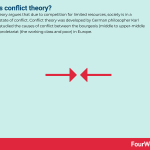

Conflict theory argues that due to competition for limited resources, society is in a perpetual state of conflict.
Understanding conflict theoryConflict theory was developed by German philosopher Karl Marx who studied the causes of conflict between the bourgeois (middle to upper-middle class) and proletariat (the working class and poor) in Europe.
Marx was particularly interested in the political, social, and economic ramifications of increasing capitalism in Europe in the mid-1800s. Since capitalism was premised on the existence of a powerful minority class of wealthy individuals and a relatively oppressed majority class, Marx believed the opportunities for conflict were rife.
Conflict theory is based on the idea that both classes are locked in a perpetual battle over resources that are not distributed evenly across society. Wealthier individuals tend to hoard the resources they possess, while poorer individuals do whatever they can to obtain them. These incompatible interests are the drivers of conflict.
Note that Max believed conflict itself was neither good nor bad and instead, should be considered a natural human tendency that most default to. As a consequence, the theory could be used to explain any social phenomenon such as revolution, war, violence, discrimination, and most other forms of injustice.
Conflict theory in economicsIn an economic context, Marx focused on two factors:
The mode of production – in other words, an industrial factory, andRelations of production – a term describing the unequal balance of power between factory workers and factory owners.Since the bourgeoisie owns (and controls) the mode of production, they tend to exploit the proletariat as a way to increase profits. The proletariat has much less power, with only their labor to sell and no access or control over capital.
This causes the common predicament where the proletariat works as little as possible to be paid as much as possible. The bourgeois factory owners, on the other hand, want the proletariat to work as hard as possible for the least amount of pay.
Conflict theory in financeGovernments attempt to manage conflict over financial resources via the reallocation of funds between the rich and the poor. Some common initiatives include a mandated minimum wage, special incentives, favorable tax structures, and social assistance.
The underlying belief behind these measures is that a wealth gap that becomes too wide will cause social unrest to ensue. This may range from a peaceful protest on one end of the spectrum to outright civil war. Advocates of conflict theory believe the government bailouts and Occupy Wall Street movement that occurred during the 2008 GFC is one prime example.
Indeed, competition for limited resources ultimately reached a point where the government needed to intervene to redistribute resources more effectively. Since that time, the divide between the rich and poor has grown once more and there may be similar conflicts in the near future.
Key takeaways:Conflict theory argues that due to competition for limited resources, society is in a perpetual state of conflict. It was developed by German philosopher Karl Marx who studied the class conflict between the wealthy and not-so-wealthy.In an economic context, conflict theory deals with the interaction between the mode of production and relations of production. Workers attempt to work as little as possible for the maximum amount of pay, while factory owners strive to pay the lowest possible wage while extracting maximum worker productivity.Governments attempt to manage conflict over financial resources via the reallocation of funds between the rich and the poor. This can be achieved via numerous initiatives or as a response to financial events such as the GFC.Main Free Guides:
Business ModelsBusiness CompetitionBusiness StrategyBusiness DevelopmentDigital Business ModelsDistribution ChannelsMarketing StrategyPlatform Business ModelsRevenue ModelsTech Business ModelsConnected Business Concepts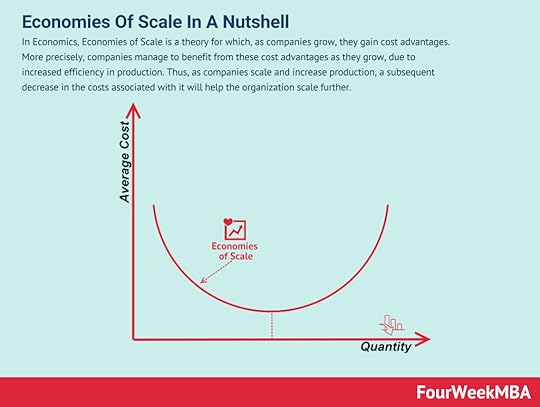 In Economics, Economies of Scale is a theory for which, as companies grow, they gain cost advantages. More precisely, companies manage to benefit from these cost advantages as they grow, due to increased efficiency in production. Thus, as companies scale and increase production, a subsequent decrease in the costs associated with it will help the organization scale further.
In Economics, Economies of Scale is a theory for which, as companies grow, they gain cost advantages. More precisely, companies manage to benefit from these cost advantages as they grow, due to increased efficiency in production. Thus, as companies scale and increase production, a subsequent decrease in the costs associated with it will help the organization scale further.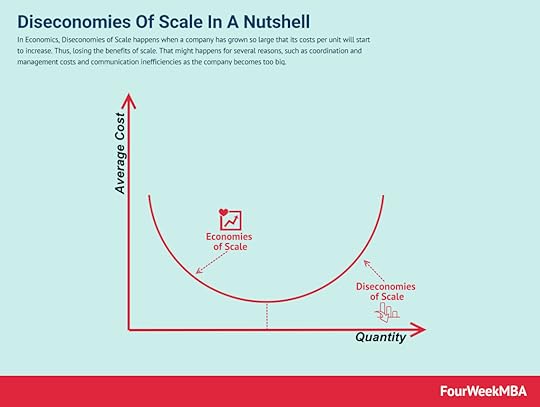 In Economics, a Diseconomy of Scale happens when a company has grown so large that its costs per unit will start to increase. Thus, losing the benefits of scale. That can happen due to several factors arising as a company scales. From coordination issues to management inefficiencies and lack of proper communication flows.
In Economics, a Diseconomy of Scale happens when a company has grown so large that its costs per unit will start to increase. Thus, losing the benefits of scale. That can happen due to several factors arising as a company scales. From coordination issues to management inefficiencies and lack of proper communication flows. In a negative network effect as the network grows in usage or scale, the value of the platform might shrink. In platform business models network effects help the platform become more valuable for the next user joining. In negative network effects (congestion or pollution) reduce the value of the platform for the next user joining.
In a negative network effect as the network grows in usage or scale, the value of the platform might shrink. In platform business models network effects help the platform become more valuable for the next user joining. In negative network effects (congestion or pollution) reduce the value of the platform for the next user joining.  In a negative network effect as the network grows in usage or scale, the value of the platform might shrink. In platform business models network effects help the platform become more valuable for the next user joining. In negative network effects (congestion or pollution) reduce the value of the platform for the next user joining.
In a negative network effect as the network grows in usage or scale, the value of the platform might shrink. In platform business models network effects help the platform become more valuable for the next user joining. In negative network effects (congestion or pollution) reduce the value of the platform for the next user joining.  Creative destruction was first described by Austrian economist Joseph Schumpeter in 1942, who suggested that capital was never stationary and constantly evolving. To describe this process, Schumpeter defined creative destruction as the “process of industrial mutation that incessantly revolutionizes the economic structure from within, incessantly destroying the old one, incessantly creating a new one.” Therefore, creative destruction is the replacing of long-standing practices or procedures with more innovative, disruptive practices in capitalist markets.
Creative destruction was first described by Austrian economist Joseph Schumpeter in 1942, who suggested that capital was never stationary and constantly evolving. To describe this process, Schumpeter defined creative destruction as the “process of industrial mutation that incessantly revolutionizes the economic structure from within, incessantly destroying the old one, incessantly creating a new one.” Therefore, creative destruction is the replacing of long-standing practices or procedures with more innovative, disruptive practices in capitalist markets. Happiness economics seeks to relate economic decisions to wider measures of individual welfare than traditional measures which focus on income and wealth. Happiness economics, therefore, is the formal study of the relationship between individual satisfaction, employment, and wealth.
Happiness economics seeks to relate economic decisions to wider measures of individual welfare than traditional measures which focus on income and wealth. Happiness economics, therefore, is the formal study of the relationship between individual satisfaction, employment, and wealth. In a command economy, the government controls the economy through various commands, laws, and national goals which are used to coordinate complex social and economic systems. In other words, a social or political hierarchy determines what is produced, how it is produced, and how it is distributed. Therefore, the command economy is one in which the government controls all major aspects of the economy and economic production.
In a command economy, the government controls the economy through various commands, laws, and national goals which are used to coordinate complex social and economic systems. In other words, a social or political hierarchy determines what is produced, how it is produced, and how it is distributed. Therefore, the command economy is one in which the government controls all major aspects of the economy and economic production. The term “animal spirits” is derived from the Latin spiritus animalis, loosely translated as “the breath that awakens the human mind”. As far back as 300 B.C., animal spirits were used to explain psychological phenomena such as hysterias and manias. Animal spirits also appeared in literature where they exemplified qualities such as exuberance, gaiety, and courage. Thus, the term “animal spirits” is used to describe how people arrive at financial decisions during periods of economic stress or uncertainty.
The term “animal spirits” is derived from the Latin spiritus animalis, loosely translated as “the breath that awakens the human mind”. As far back as 300 B.C., animal spirits were used to explain psychological phenomena such as hysterias and manias. Animal spirits also appeared in literature where they exemplified qualities such as exuberance, gaiety, and courage. Thus, the term “animal spirits” is used to describe how people arrive at financial decisions during periods of economic stress or uncertainty. State capitalism is an economic system where business and commercial activity is controlled by the state through state-owned enterprises. In a state capitalist environment, the government is the principal actor. It takes an active role in the formation, regulation, and subsidization of businesses to divert capital to state-appointed bureaucrats. In effect, the government uses capital to further its political ambitions or strengthen its leverage on the international stage.
State capitalism is an economic system where business and commercial activity is controlled by the state through state-owned enterprises. In a state capitalist environment, the government is the principal actor. It takes an active role in the formation, regulation, and subsidization of businesses to divert capital to state-appointed bureaucrats. In effect, the government uses capital to further its political ambitions or strengthen its leverage on the international stage. The boom and bust cycle describes the alternating periods of economic growth and decline common in many capitalist economies. The boom and bust cycle is a phrase used to describe the fluctuations in an economy in which there is persistent expansion and contraction. Expansion is associated with prosperity, while the contraction is associated with either a recession or a depression.
The boom and bust cycle describes the alternating periods of economic growth and decline common in many capitalist economies. The boom and bust cycle is a phrase used to describe the fluctuations in an economy in which there is persistent expansion and contraction. Expansion is associated with prosperity, while the contraction is associated with either a recession or a depression.The post What is conflict theory? appeared first on FourWeekMBA.



